EDITOR’S NOTE: Please be advised that as of 22 January 2024, the US Department of State is advising against all travel to Myanmar due to “civil unrest, armed conflict, and arbitrary enforcement of local laws.” Please visit travel.state.gov for more information.
Many years ago, I was having a lunch meeting with a Frenchman who had been living in Shanghai for over two decades. We were talking about travel and he told me that the most incredible sight he had ever seen were the temples in Bagan. He had gone up in a hot air balloon and was awestruck by the landscape of Buddhist temples as far as the eye could see.
That conversation from over a decade ago seared a mental image in my brain. I needed to see this ocean of temples for myself so when I was sent to Yangon on a project, I made sure to spend a few days in Bagan.
As I had hoped, the Frenchman wasn’t exaggerating nor was he speaking in metaphors. Bagan had thousands of ancient temples spread out over a vast plain, literally as far as the eye could see. It was spectacular.
Save This on Pinterest!
No time to read this now? Click on the red save button and pin it for later!
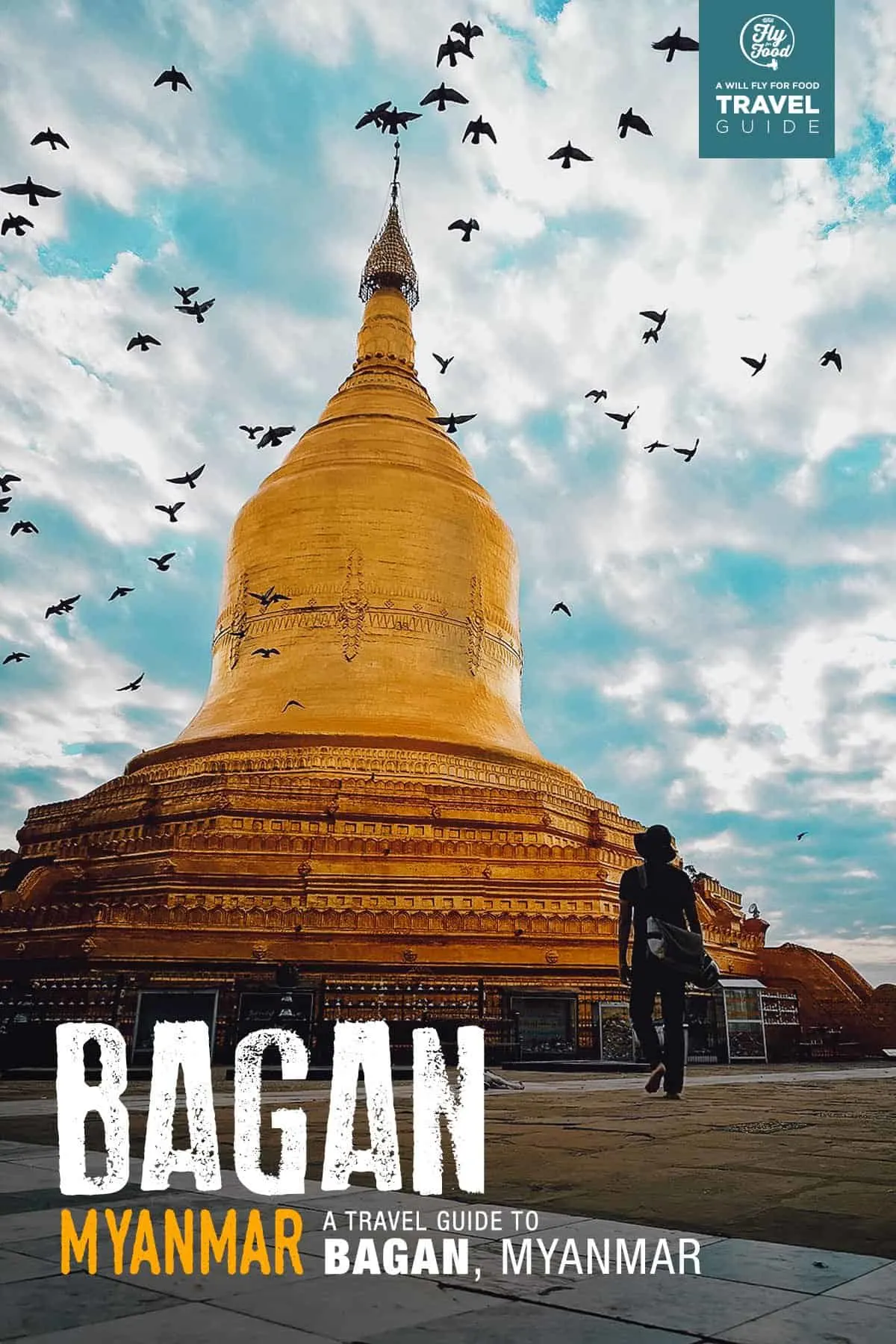
GUIDE TABLE OF CONTENTS
TRAVEL RESTRICTIONS
Because of the current global situation, travel guidelines change regularly. Our friends at SafetyWing created a website that lists detailed information on travel restrictions around the globe.
Before planning a trip to Bagan, be sure to check the Flatten the Curve website for information on travel restrictions to Myanmar.
BAGAN AT A GLANCE
The ancient city of Bagan is located in the Mandalay region of Myanmar, about 630 km north of Yangon. From the 9th to the 13th centuries, it served as the capital of the Pagan Kingdom, the first kingdom to unify the regions that would later constitute modern-day Myanmar.
During that time, over 10,000 Buddhist temples, pagodas, and monasteries were constructed in the region, of which an estimated 3,822 still stand today in varying states of preservation. This cluster of religious monuments built in an area of about 104 square kilometres (40 square miles) is what makes Bagan one of Myanmar’s most popular and intriguing tourist destinations.
Surprisingly, in spite of its unique landscape of ancient temples, it wasn’t until July of 2019 that Bagan was inscribed as a UNESCO World Heritage Site, after almost 25 years since its first nomination.
BEST TIME TO VISIT
Bagan has a similar climate to Yangon. It doesn’t get nearly as much rainfall but the weather patterns are almost the same. The rainy season is from June till October while the dry season is from November to May. June to August sees the most rain while March till May are usually the hottest months. The ideal time to visit is anywhere between November till February.
NOV-FEB: This is the dry season and the best time to visit Bagan. I was there in mid-December and the weather was almost perfect. It was a bit drizzly for a couple of hours one day but other than that, the skies were clear.
MAR-MAY: This is still the dry season, but it’s also the hottest time of the year with the temperature often reaching 43°C (109°F). You’ll be out and exposed for much of the day so this probably isn’t the best time to go.
JUN-OCT: The rainy season starts around June and goes until October. With that said, Bagan is in Myanmar’s dry zone so it doesn’t get as much rain even during the wet season. Based on what I’ve read, it typically rains in the morning leaving you with relatively clear skies to go out and explore in the afternoon.
Climate: Annual Monthly Weather in Bagan
For more on Bagan’s weather, check out these climate graphs from weatherbase.com. I’ve created the average temperature and annual rainfall graphs below with the most ideal months to visit marked in orange.
Average Temperature
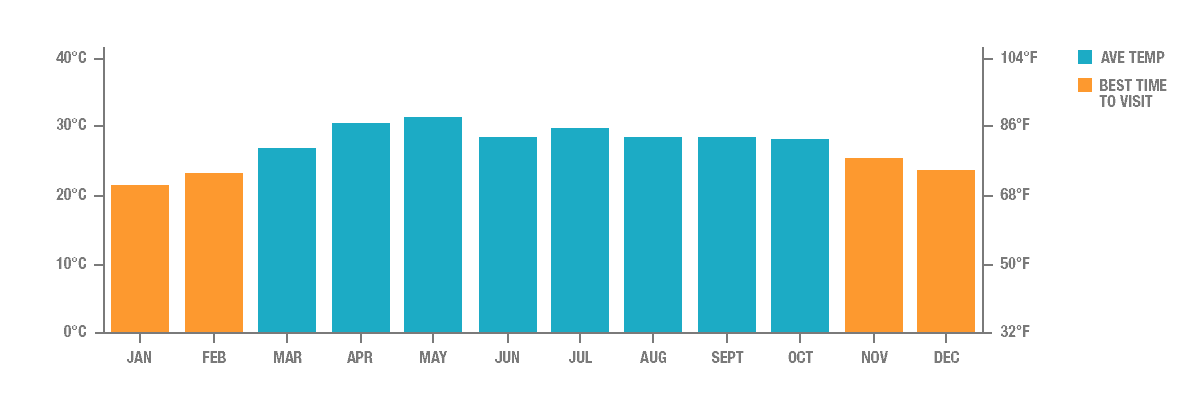
Annual Rainfall
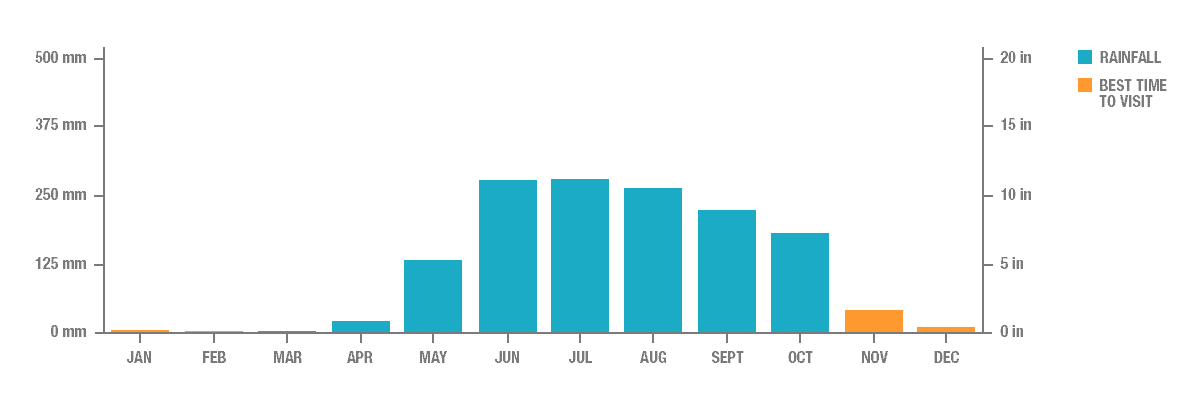
TRAVELING TO BAGAN
There are many ways to get to Bagan depending on where you are, but for the sake of this guide, let’s assume you’re coming from Yangon.
BY BUS: This is what I did. Going by overnight bus seems to be the most popular way of getting to Bagan from Yangon. It’s much cheaper than a flight and much faster than the train, plus the buses are very comfortable. You can book bus tickets on Bookaway.
As you can see below, I had a tv screen and I could recline my seat to a sleeping position, plus I was given a blanket and served a meal. The bus ride takes about ten hours. We left Aung Mingalar station in Yangon at 8PM and arrived at Bagan Shwe Pyi terminal at 6AM. You can then take a taxi to your hotel.
The taxi fare should cost you anywhere between MMK 5,000-10,000, but don’t be surprised if you’re quoted a much higher fare than that. There’s a known taxi mafia in Bagan that preys on tourists arriving at the bus terminal. Follow the link for more on Bagan’s taxi mafia.
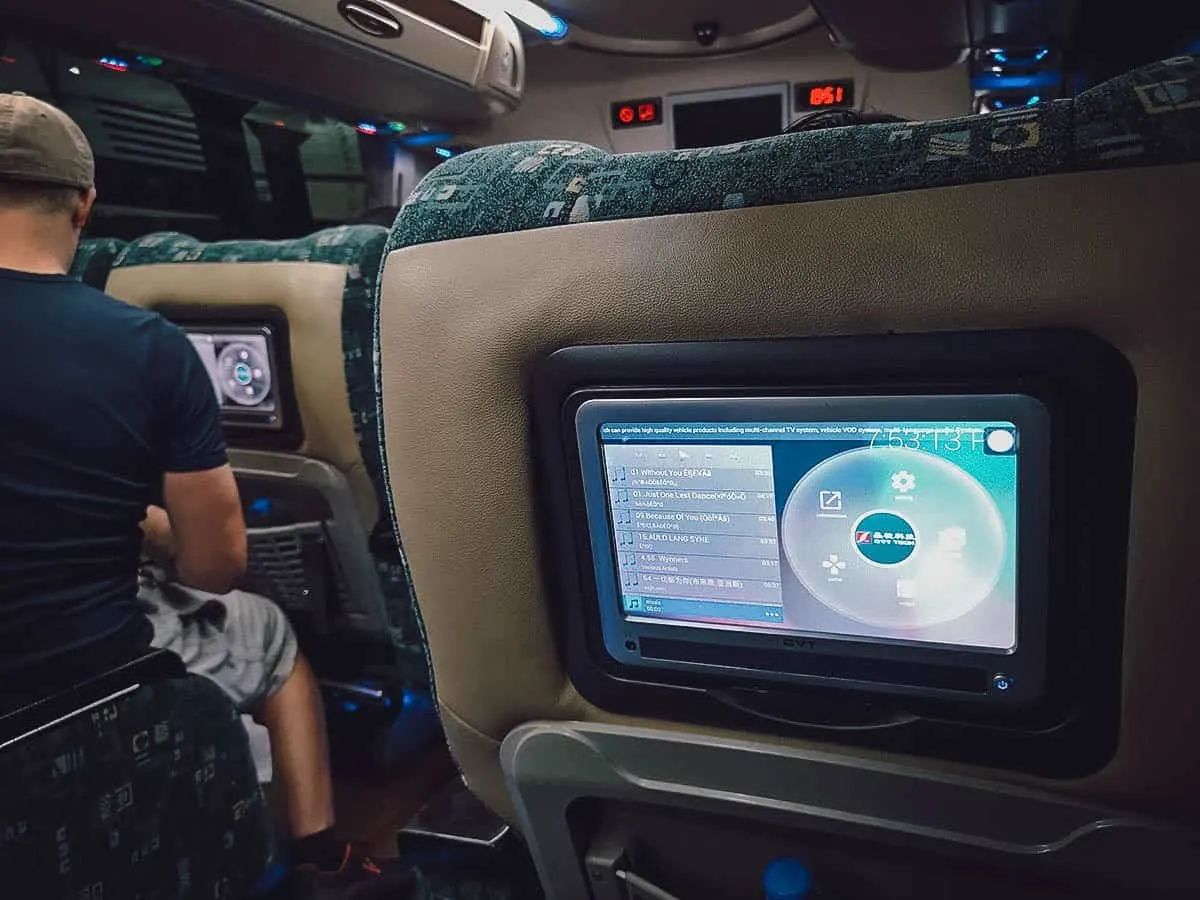
BY PLANE: This is considerably more expensive than the bus but it’s also much faster. The flight from Yangon Airport to Nyaung-U Airport takes about an hour and a half. You can book flights through Skyscanner. I read that taxi fares from the airport are fixed so it should cost you anywhere between MMK 5,000-10,000 to get to your hotel.
BY TRAIN: I’m not sure what the advantages are of taking the train. It costs about the same as the bus but the journey is much longer, about 17 hrs 30 mins. Perhaps it’s a more romantic way of traveling through Myanmar? Whatever the case, I’m not sure if the taxi mafia operates out of the railway station but I’m guessing probably not. Trains arrive later in the morning, at around 9:30AM, so you’ll have more chances of finding honest taxi drivers. It should cost you anywhere between MMK 5,000-10,000 to get to your hotel.
If you’re traveling to Bagan from somewhere other than Yangon, then you can check out Bookaway to find route options available to you. You can click on the link or use the widget below.
WHERE TO EXCHANGE CURRENCY
The unit of currency in Myanmar is the Burmese Kyat (MMK). I already had MMK with me so I didn’t need to exchange currency in Bagan, but I’ve read that the best places to do so are at banks. The currency exchange offices at Ngyaung U Airport give great rates as well. Just remember that bills need to be in pristine condition and USD 100 bills get you the best rates.
I used to exchange currency all the time but I find myself withdrawing more and more from ATMs these days. Rates are competitive and you won’t need to bring large sums of foreign currency with you. Just be sure to let your bank know that you plan on using your ATM card abroad so you don’t run into any problems. In my experience, my card works in some machines but not in others.
NOTE: Some ATMs may ask if you’d like to proceed “with or without conversion”. Never proceed with conversion because that authorizes the foreign bank operating the ATM to perform the conversion for you, usually at poor rates. Instead, proceed WITHOUT conversion. According to this article, the difference in rates can be as high as 10%.
BEST AREA TO STAY
Bagan isn’t that big and there are basically three areas where you can stay – Nyaung-U, Old Bagan, and New Bagan.
If you’re wondering where to stay to be close to the temples, then that would be Old Bagan. But there are no budget hotels there and restaurant options are few and far between. The Bagan Archaeological Zone is big but not insurmountably big so I don’t think proximity to the temples matters that much. You won’t be exploring them on foot anyway.
Personally, I think Nyaung-U is the best and most convenient place to stay. I’ve created the color-coded map below to help you better understand where each of these areas are. Click on the link for an interactive version of the map. (Please note that marked areas are approximations only)
GREEN – Nyaung-U
BLUE – Old Bagan
ORANGE – New Bagan
I’ll provide targeted links under each area description but you can book accommodations in Bagan through Booking.com or Agoda.
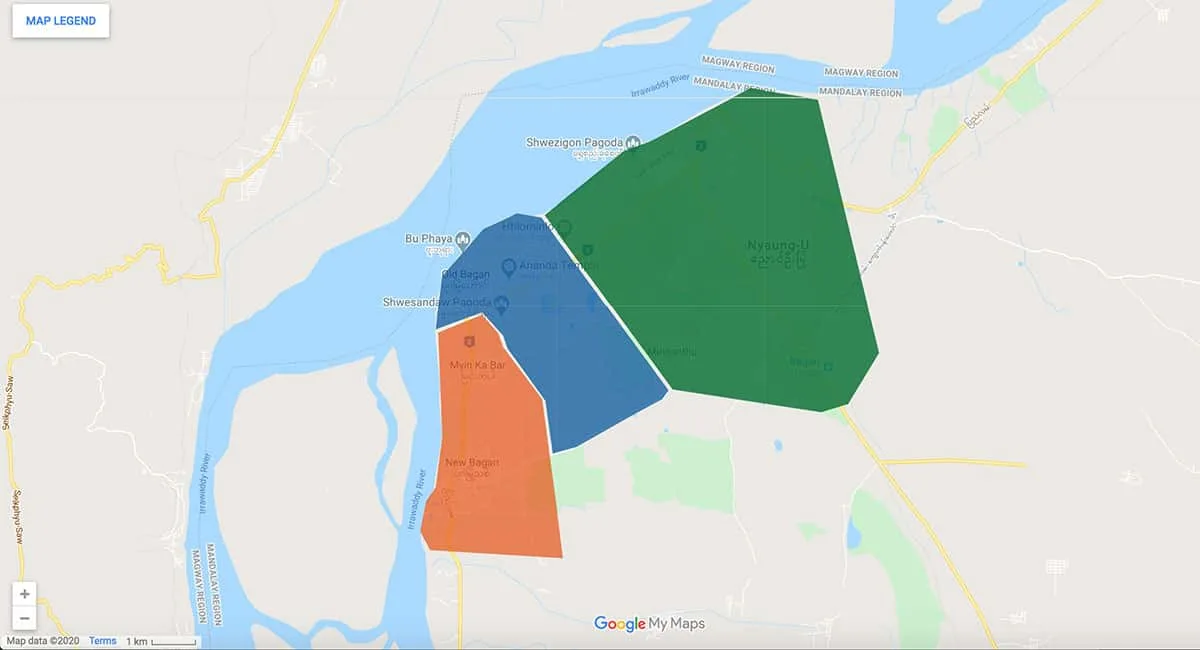
NYAUNG-U: New Park Hotel
This is where I stayed. It’s the area closest to the airport and the bus and railway stations. It’s the liveliest area in Bagan and home to plenty of shops, lodging, and dining options.
New Park Hotel isn’t the fanciest hotel in Bagan but it’s inexpensive and centrally located. My JJ Express bus ticket back to Yangon included free pickup at this very hotel which made it even more convenient.
You can make a booking at New Park Hotel through Booking.com or Agoda. If you’d like to stay in Nyaung-U but don’t feel this is the right place for you, then you can search for alternate listings on Booking.com or Agoda.
Approximate Room Rate: USD 16 per night (as of December 2019)
OLD BAGAN
Old Bagan is where you’ll find most of the area’s temples. However, it doesn’t have nearly as many lodging or dining options. Hotels here are the most expensive so if you’re looking for the most luxurious, all-inclusive stay in Bagan, then this is where you’ll want to be. You can search for hotels in Old Bagan on Booking.com or Agoda.
NEW BAGAN
New Bagan is the area directly west of Old Bagan. There are more lodging and dining options here than Old Bagan, but it isn’t as lively as Nyaung-U. It’s also the area farthest away from the airport and bus and train stations. There are a few temples in the area and I visited two restaurants here, but personally, I’d rather stay in Nyaung-U. It’s easy enough to get here on an e-bike anyway. You can search for hotels in New Bagan on Booking.com or Agoda.
MOST POPULAR TEMPLES
According to Wikipedia, there are over 3,800 temples in the Bagan Archaeological Zone. I had the most fun just cruising around on my e-bike and randomly exploring temples, but if you’re looking for the most popular, then you can start with these eight.
I’m not an expert on these temples so I’ll only give a brief description of each, but if you’d like to learn more about them, then you can check out RenownTravel’s series on Bagan’s temples.
1. Thatbyinnyu Temple
Built in 1144, Thatbyinnyu stands at just over 60 meters (197 ft) and is one of the tallest temples in Bagan. It was constructed during the reign of King Alaungsithu and was one of the first two-story temples built at the time.
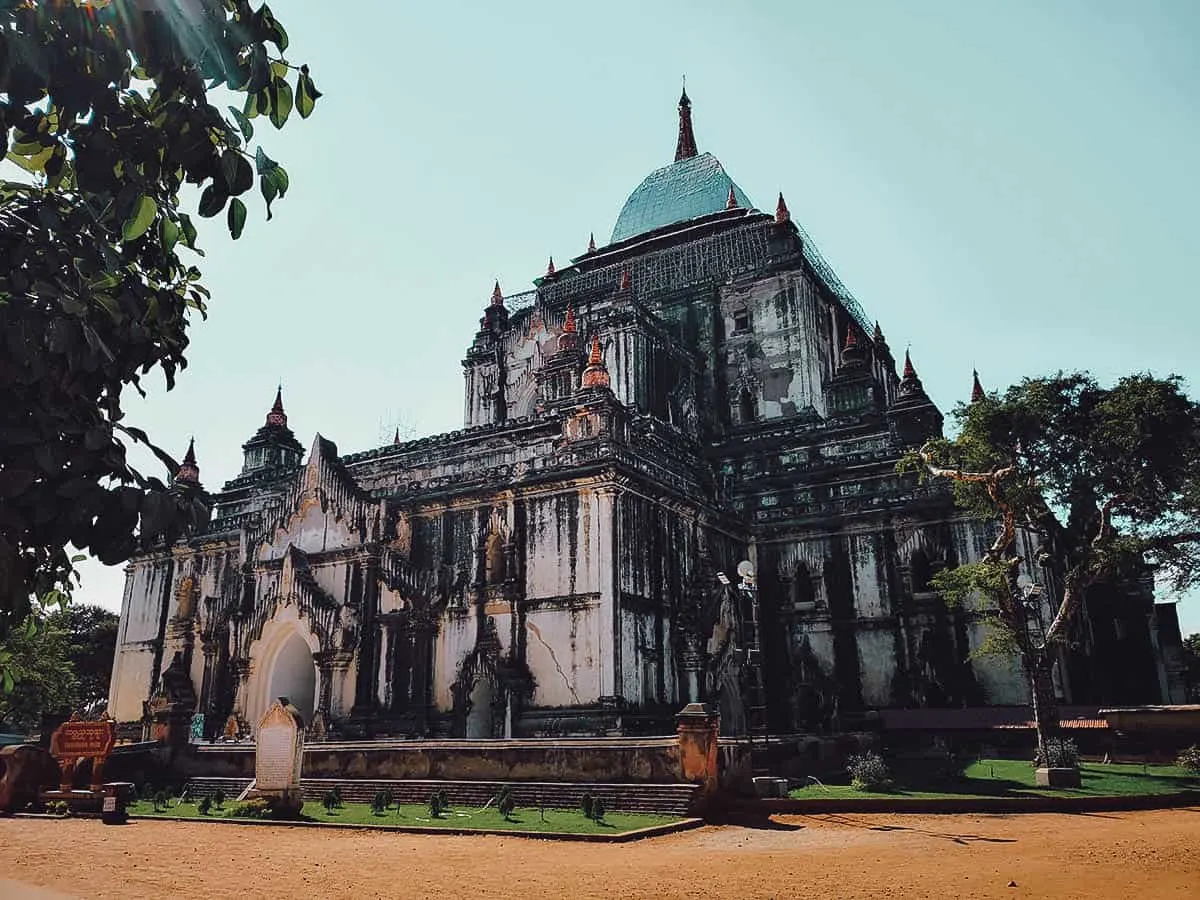
2. Shwegu Gyi Phaya
Shwegugyi Temple was built in 1131, also during the rule of King Alaungsithu. It was constructed on a 3-meter tall (13 ft) brick foundation and is known for its arched window design. According to inscriptions at the temple, it was completed in seven months.
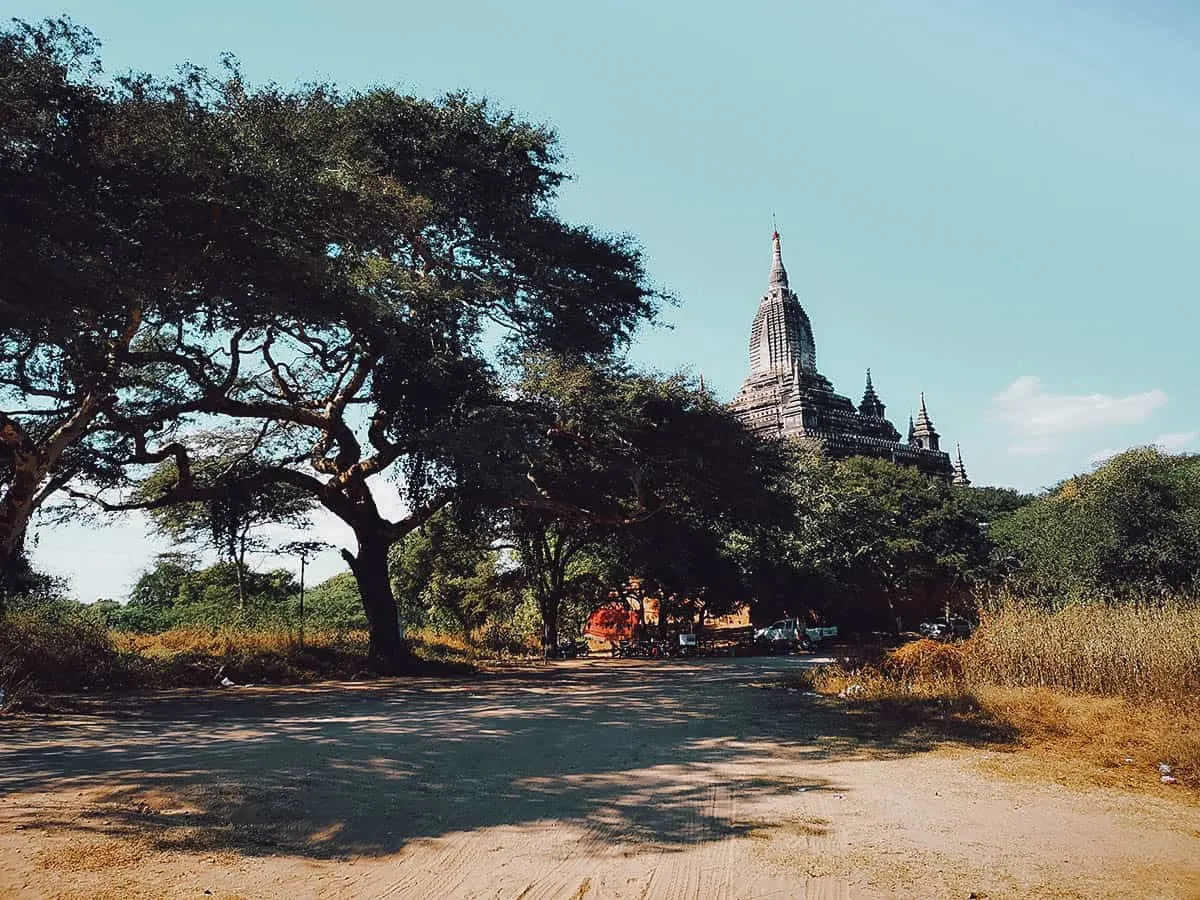
3. Ananda Pahto
Built in 1105 under the rule of King Kyanzittha, Ananda Pagoda is one Bagan’s most beautiful and well-preserved temples. It was built in the shape of a cross with multiple terraces leading to a small pagoda at the top capped by a gilded sikhara. Described as a fusion of Mon and North Indian architectural styles, it was one of if not the most impressive temples I visited in Bagan. Don’t miss it.
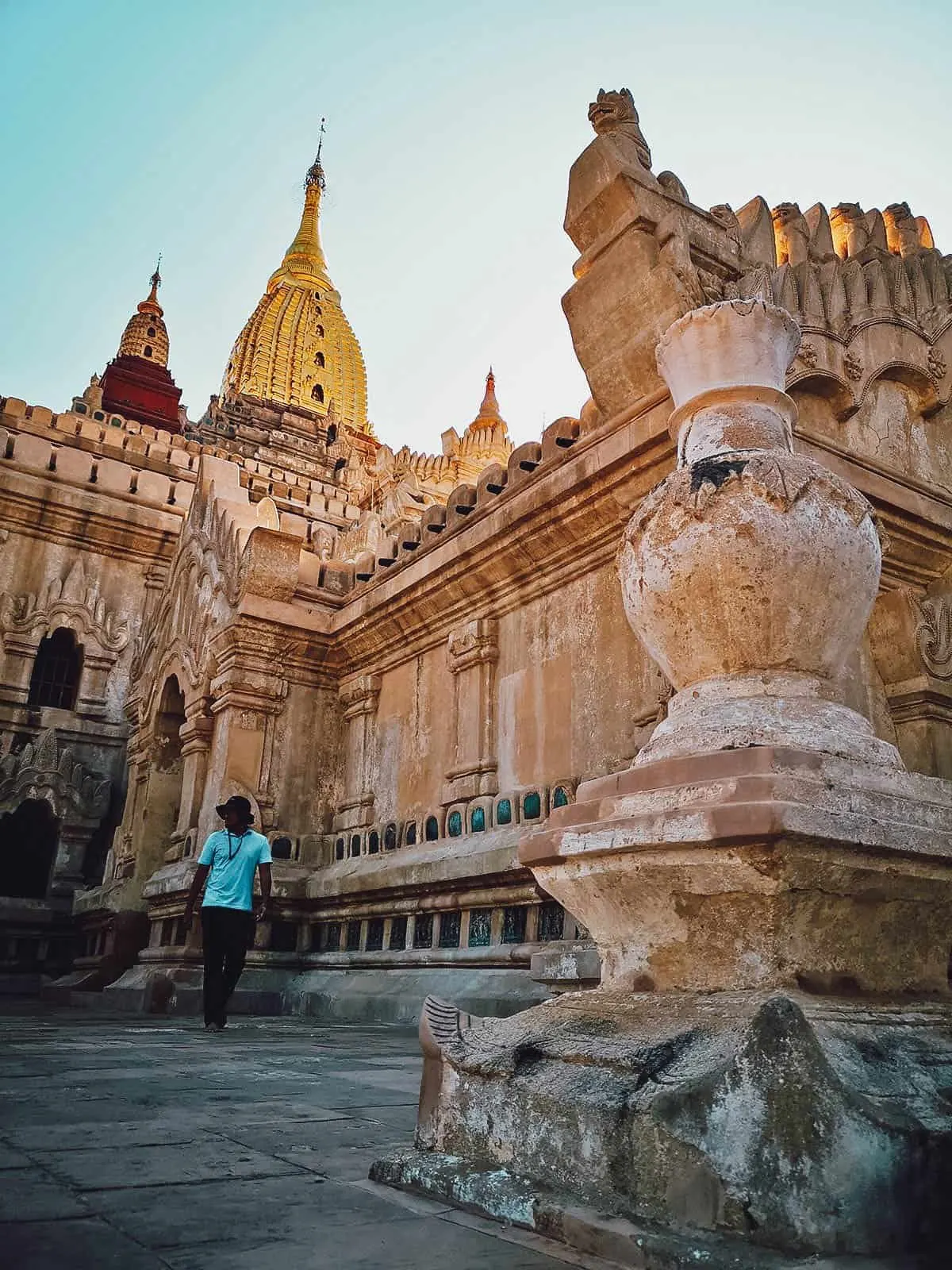
4. Htilominlo Pahto
Htilominlo Temple was constructed in 1218 and was named after its builder, King Htilominlo. Built with red brick, it’s a three-story temple standing 46 meters tall (151 ft). Unfortunately, it was undergoing restoration work at the time of my visit which is why it’s missing its sikhara in this picture.
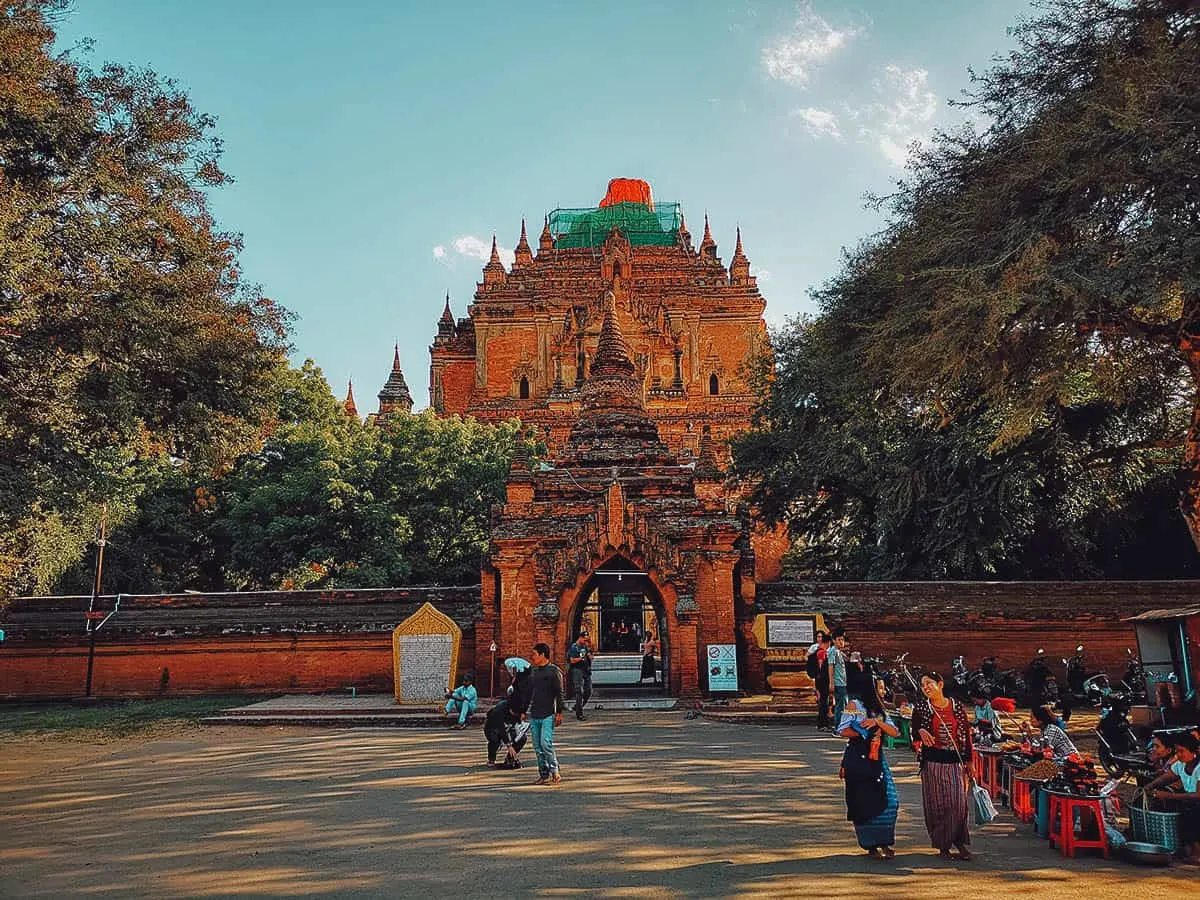
5. Shwezigon Pagoda
Covered in gold, Shwezigon Pagoda is one of the most impressive and visually striking temples in Bagan. It was built in 1090 under the reign of King Anawrahta. Aside from its striking appearance, Shwezigon Pagoda is noteworthy because its believed to enshrine a bone and tooth of Gautama Buddha, making it one of the most important Buddhist pilgrimage sites in Bagan. Among the temples I visited, it was the only one located in Nyaung-U. Don’t miss this one either.
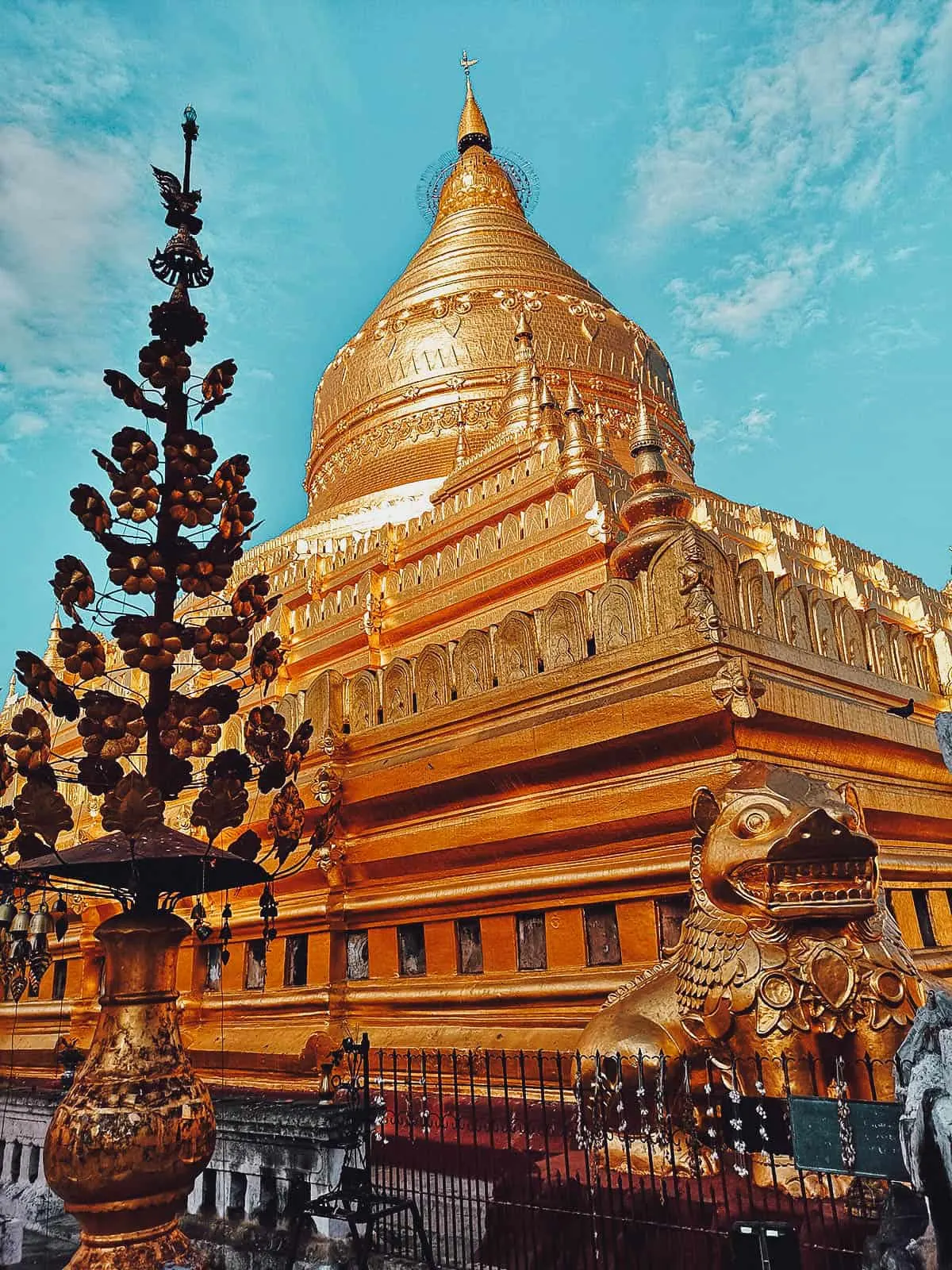
6. Dhammayazika Pagoda
Dhammayazika Pagoda was built in 1198 under the reign of King Narapatisithu. It’s known for its pagoda topped by a striking gilded bell-shaped dome.
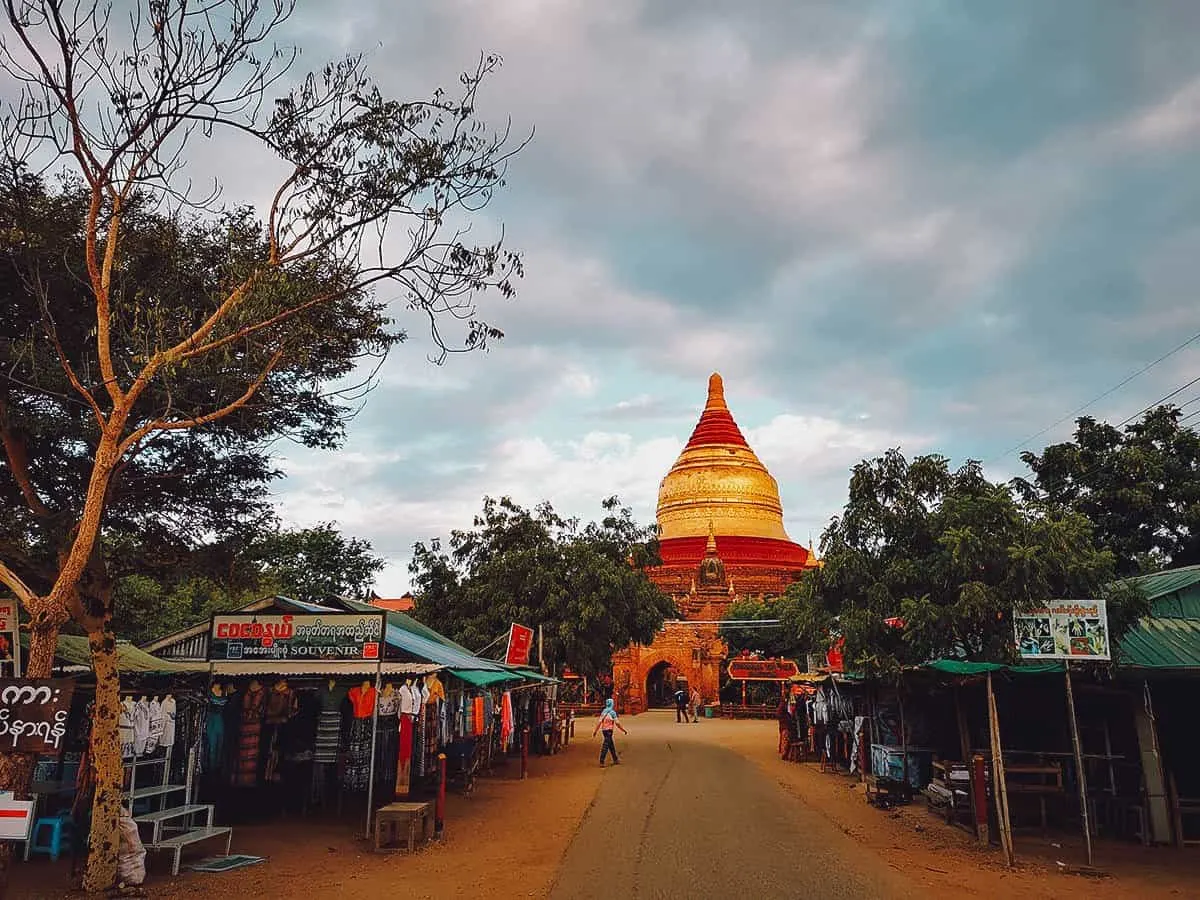
7. Dhammayangyi Pahto
Many of the temples I visited grabbed your attention because they were gilded. Dhammayangyi Temple was impressive for its sheer size. Built in 1170 under the rule of King Narathu, it’s the largest temple in Bagan. I didn’t go inside but from the road, it looks like something from a movie, which is fitting because of its intriguing backstory.
Narathu became king after murdering his father and brother, who was next in line to the throne. Historians speculate that he was worried about bad karma which is why he built Dhammayangyi Pahto, to atone for his sins. Unfortunately for Narathu, it wouldn’t do him any good as he would later be murdered himself.
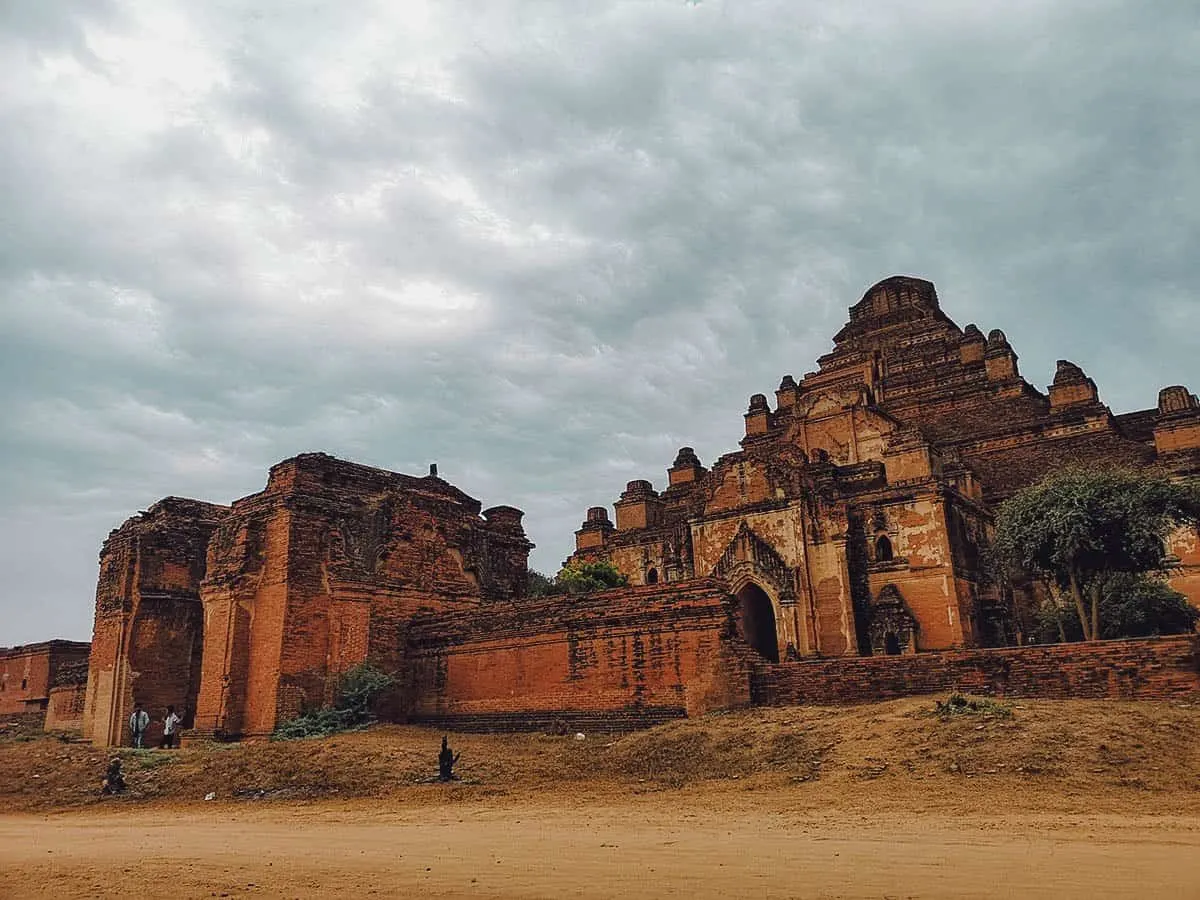
8. Shwesandaw Pagoda
Shwesandaw Pagoda was constructed in 1057 during the time of King Anawrahta. It’s comprised of a series of five terraces topped by a cylindrical stupa. Like Shwezigon Pagoda, it’s believed to contain relics of Gautama Buddha, in this case, a few strands of hair.
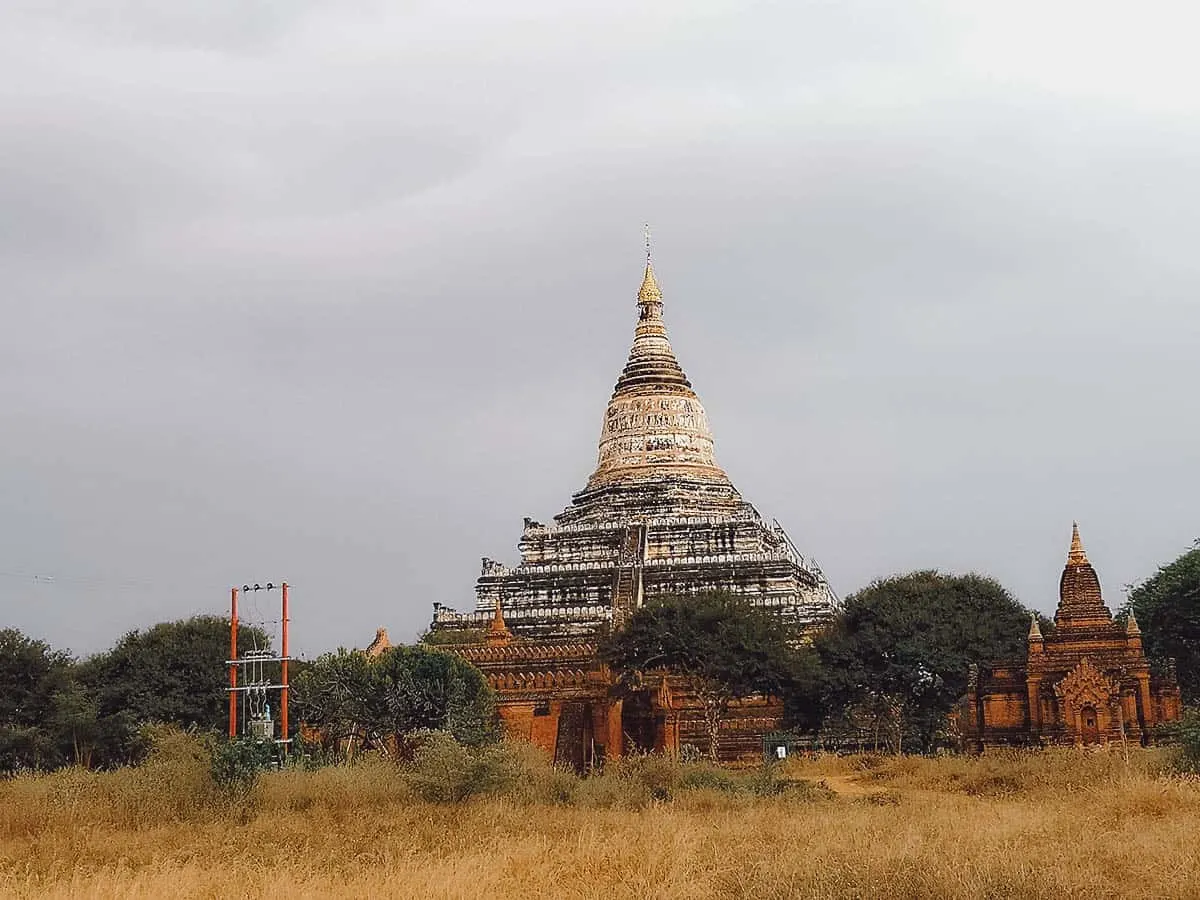
HOW TO SEE THE TEMPLES
Bagan’s temples are scattered over an area of about 104 square kilometres (40 square miles) so it isn’t possible to explore them on foot, especially under the intense midday sun. Listed below are the ways you can appreciate Bagan’s fascinating landscape of temples.
1. E-bike / Bicycle
Cruising around on an e-bike is perhaps the best and most popular way of exploring Bagan’s temples. With a top speed of about 40 km/h, you can cover more ground and you won’t tire yourself out the way you would on a bicycle. They’re more expensive than regular bikes but worth it in my opinion.
I rented this e-bike through my hotel for MMK 5,000 per day, but I think the cost may be higher at rental shops, around MMK 6,000-8,000. The battery lasts about eight hours which was perfect for my needs. I’d take it out after breakfast then bring it back to recharge at the hotel just after sunset. Bicycles are much cheaper to rent, around MMK 1,500-2,000 per day.
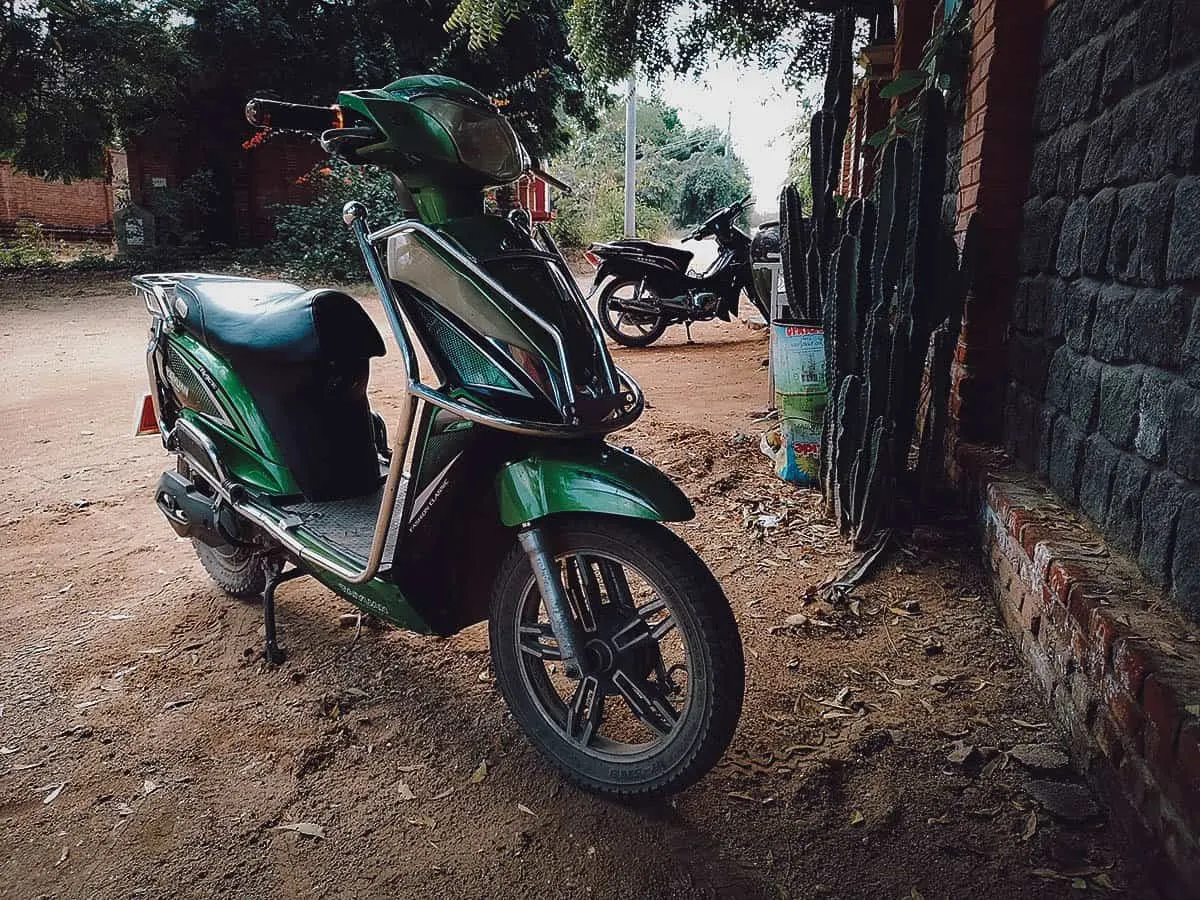
The big temples are impressive but I had the most fun getting off the main road and cruising along these dirt paths. There is so much to discover in Bagan so don’t limit yourself to the roads most traveled.
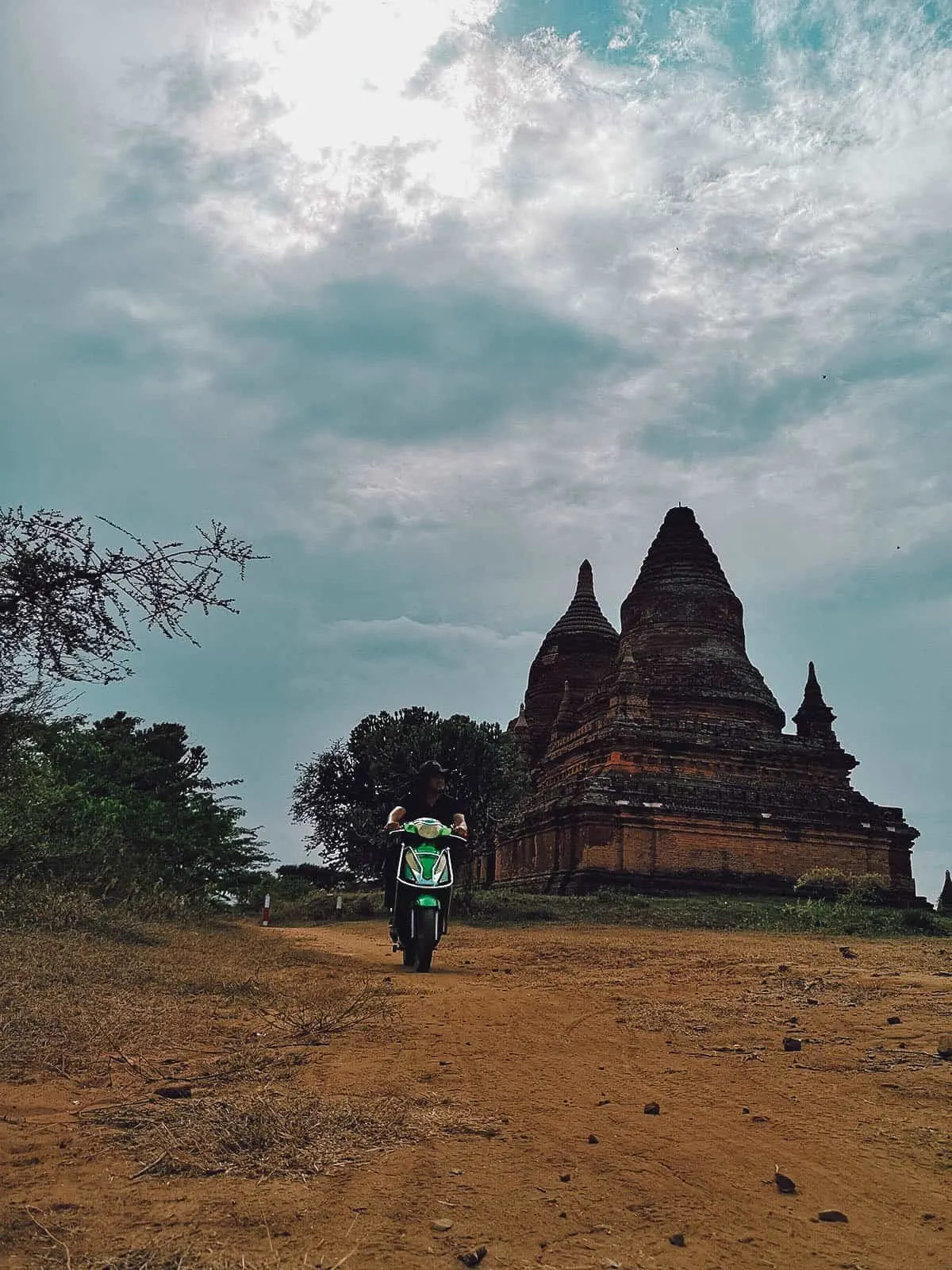
2. Hot Air Balloon
Without question, this is the most dramatic way of experiencing Bagan’s temples. But it’s also the most expensive, setting you back over USD 300 per person. If you can afford it, then go for it. We did it in Cappadocia and that remains one of the most memorable travel experiences we’ve had so far.
You can only ride hot air balloons over Bagan in the dry season, from October till March. You’ll be picked up before dawn so you’ll be up in the air before the first rays of sunrise.You can arrange for a hot air balloon experience after you arrive in Bagan.
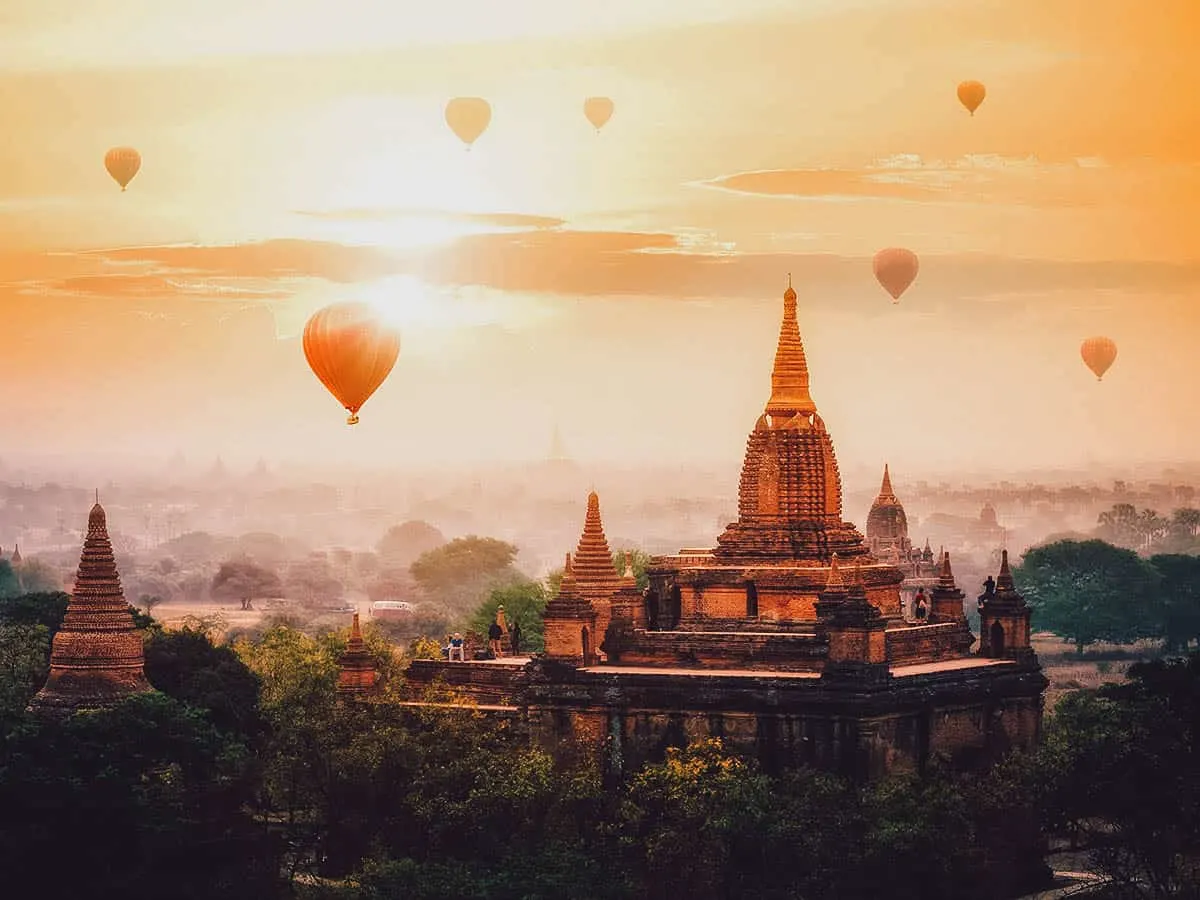
Photo by Travel mania via Shutterstock
3. Guided Tour
Going on a guided tour is probably the easiest way of seeing the most noteworthy temples in Bagan in the shortest amount of time. You don’t have to exert any effort going from temple to temple and you’ll have a guide explaining everything to you. Personally, half the fun for me was riding around on my own on an e-bike, but if you’d prefer to go on a guided tour, then you can choose one from Get Your Guide.
4. Private Car Charter
As described, I enjoyed exploring Bagan’s temples on an e-bike, but if you aren’t comfortable with that or don’t want to be exposed to the sun, then you may want to get around in a chauffeured private car. You won’t have the benefit of a guide but you can create your own itinerary and have the car to yourself. You can book one in advance through Klook.
OTHER THINGS TO DO IN BAGAN
Bagan’s temples are fascinating but they can be a bit monotonous after a while. To keep yourself from experiencing temple fatigue, you may be interested in these other activities as well.
1. Enjoy the Sunrise/Sunset
When I arrived at the bus terminal at 6AM, I hired a taxi to take me to my hotel. The cab driver told me that watching the sunrise was a popular activity in Bagan and he offered to take me to this small lake before driving to my hotel. It was too early to check in anyway so I agreed. This is what I saw – hot air balloons floating across the sky with the sun rising from behind the horizon. It was beautiful.
However, I think I may have been ripped off. A cab ride that should have been around MMK 5,000 wound up costing me MMK 23,000. Surely, this detour to watch the sunrise wasn’t worth MMK 18,000? I think I may have fallen victim to Bagan’s infamous taxi mafia.
Sunrise and sunset are indeed beautiful in Bagan but this is something you can easily do on your own. I set out early the next morning to catch the sunrise from some unknown temple and had an even better time than I did today. I suggest doing the same.
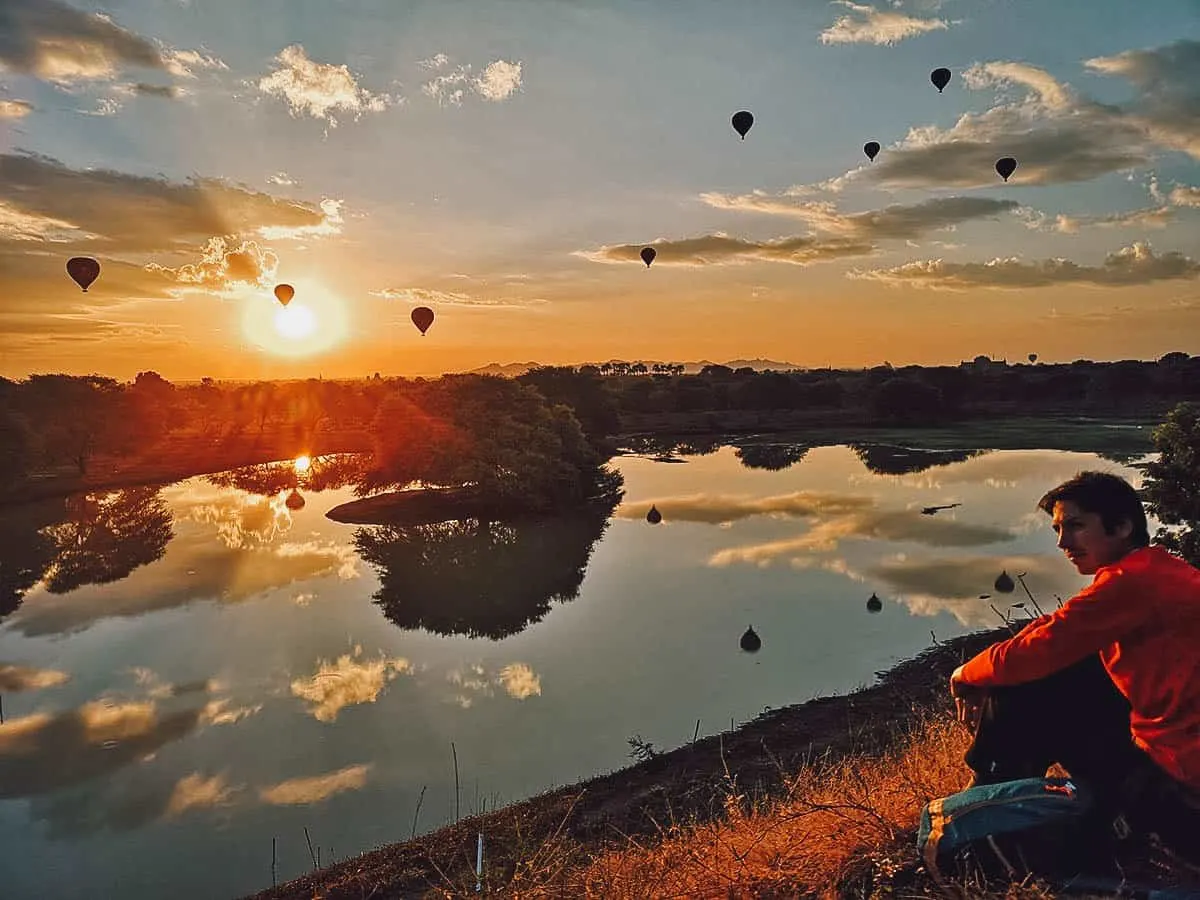
This is what sunset in Bagan looks like. I was cruising around Old Bagan when I drove by a temple with many sets of shoes by its door. I looked inside and found a set of stairs inside the temple’s walls. I went up and found a few tourists sitting on the temple’s roof, quietly taking in this amazing sunset in Bagan.
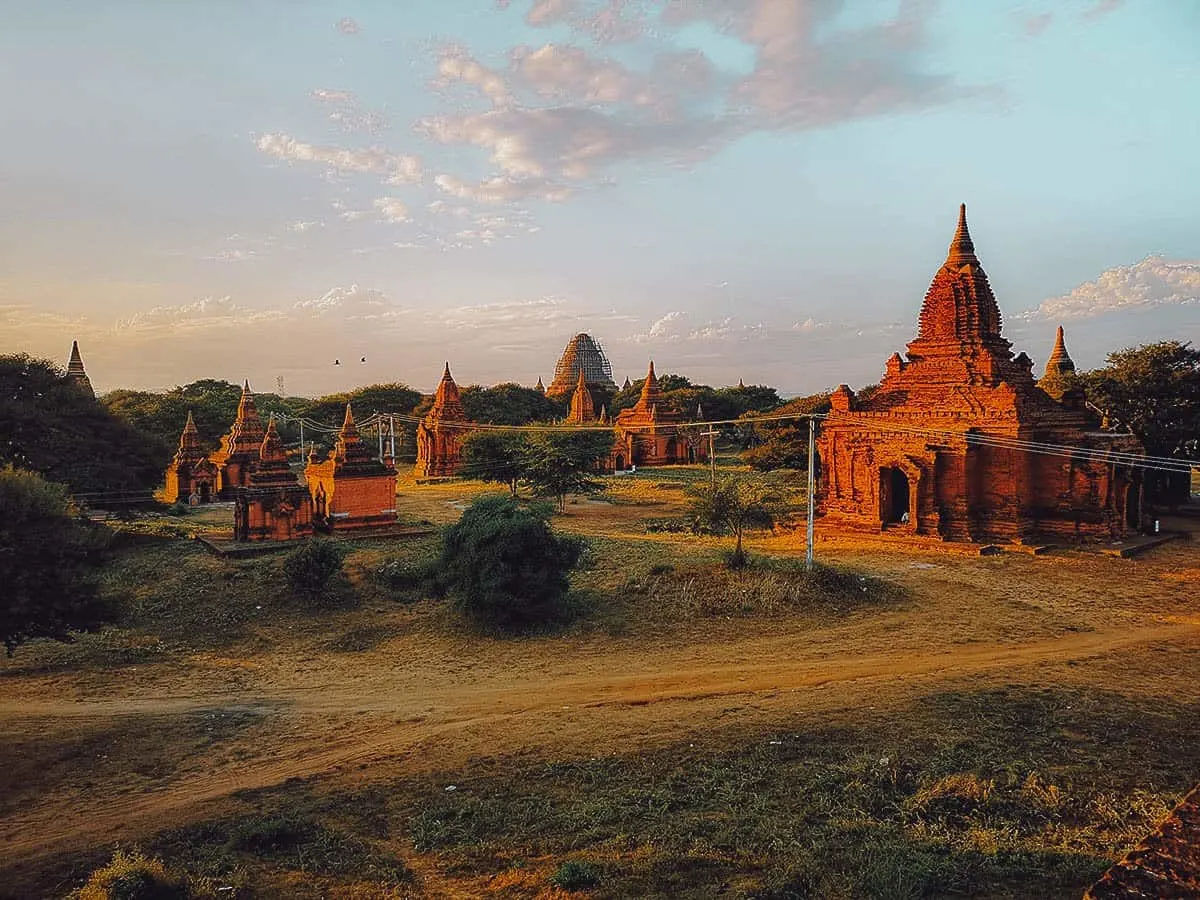
2. Get a Feel for Local Life at Mani Sithu Market
Local markets are always interesting. They’re chaotic and often smelly but they’re a window into the soul of the local community. When you’re there, you don’t feel like a tourist.
Mani Sithu Market is located in Nyaung-U. It’s a great place to visit if you’re into street photography or enjoy sightseeing at local markets. Like any Southeast Asian market, it’s best to come early in the morning when it’s at its liveliest.
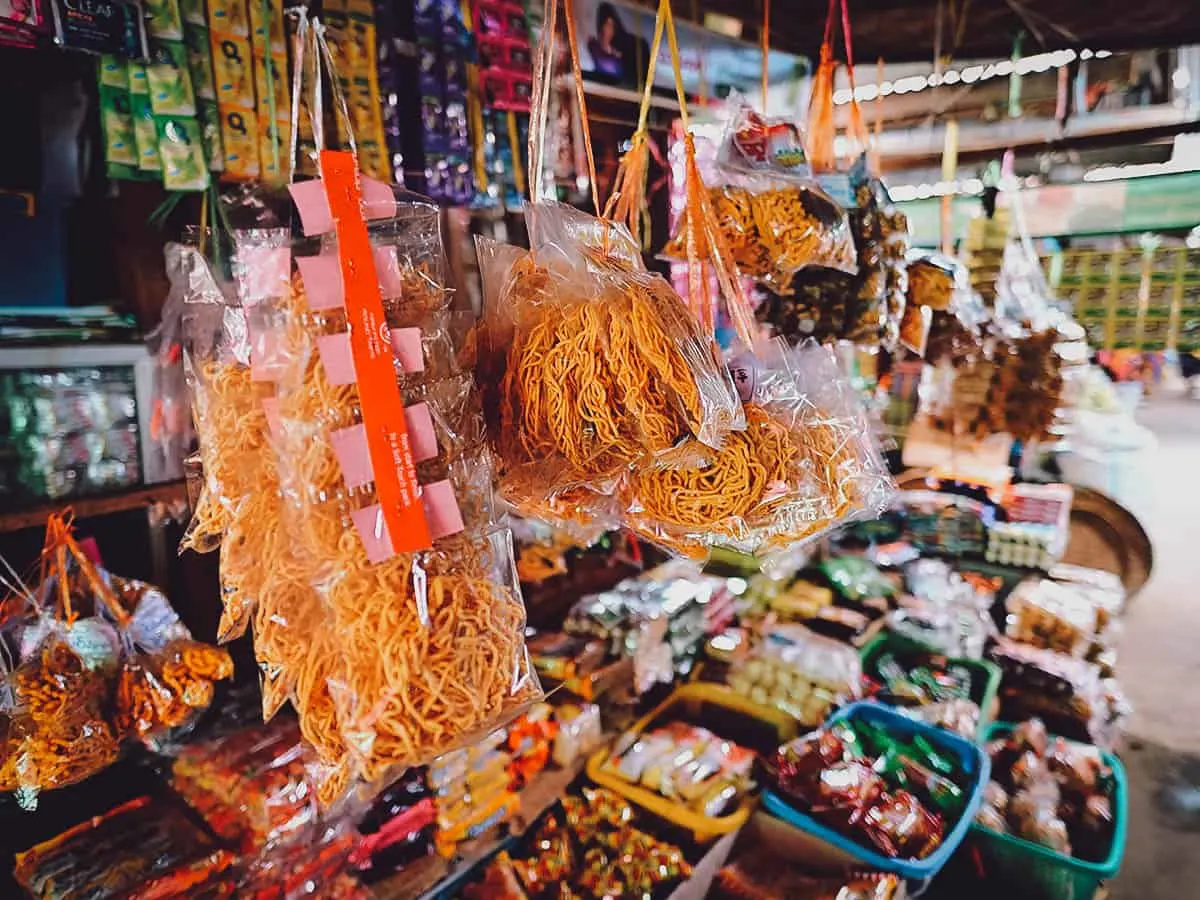
Photo by atsushi nemoto via Shutterstock
3. Visit a Lacquerware Workshop
I didn’t know this at the time but Myanmar is famous for its lacquerware. The Burmese lacquerware tradition can be traced back to Bagan where it’s been practiced by families for generations, perhaps as early as the 16th century.
There are many lacquerware shops in Bagan but I read that the best place to buy it is in Myinkaba Village, which is along the road between Old and New Bagan. It’s easy to get to as I often drove by this village on my e-bike. Even if you aren’t looking to buy anything, I believe you can just walk into any shop and watch the artisans at work.
If you have a particular interest in Burmese lacquerware and want to learn more about it, then Klook offers this guided tour to a workshop in Min Nan Thu Village.
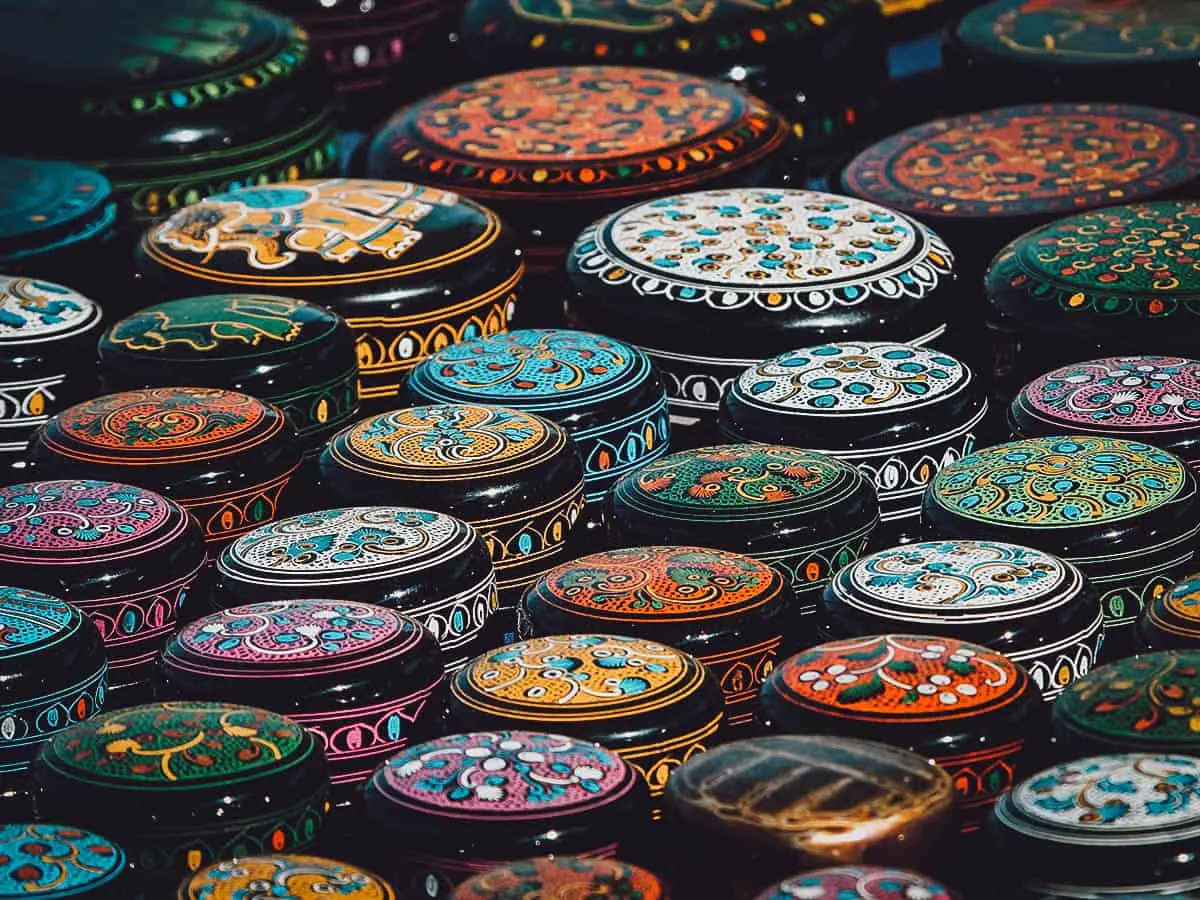
Photo by Photostravellers via Shutterstock
4. Take a Day Trip to Salay and Mt. Popa
If you’re spending enough time in Bagan, then you may want to go beyond the city and take this day tour to Salay and Mt. Popa. Located about an hour south of New Bagan, Salay is a center for lacquerware manufacturing and home to many Buddhist monasteries, including Yokesone Monastery and its abundance of intricate woodcarvings.
From there, you’ll be taken to Mt. Popa which is an extinct volcano about 1,518 meters (4,981 ft) above sea level. One of of its most distinguishing features is this sheer volcanic rock formation with a Buddhist temple sitting on top. The tour lasts about ten hours and you can book it on Klook.
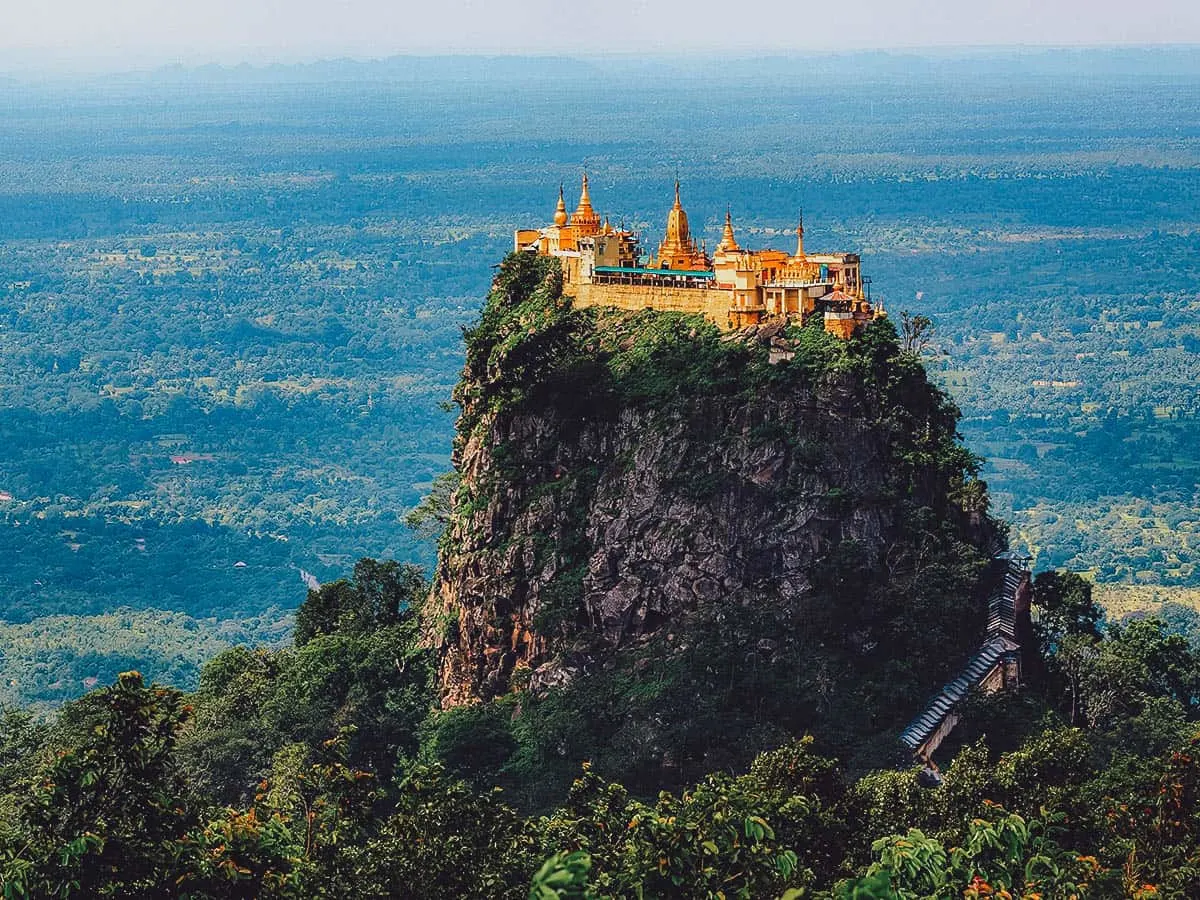
Photo by Avigator Fortuner via Shutterstock
5. Take a Sunset Cruise on the Irrawaddy River
One of the most enjoyable moments I had in Bagan was looking out at the Irrawaddy River from Lawkananda Pagoda at sunset. I was watching a boat sail up the river and I remember wondering how this pagoda with its gilded stupa must have looked from the water. Perched atop a hill, shimmering in the golden waning light of sunset, it must have looked spectacular.
You already know how to appreciate Bagan’s temples from the land and sky. If you’d like to see them from the river, then you may be interested in this sunset cruise on the Irrawaddy.
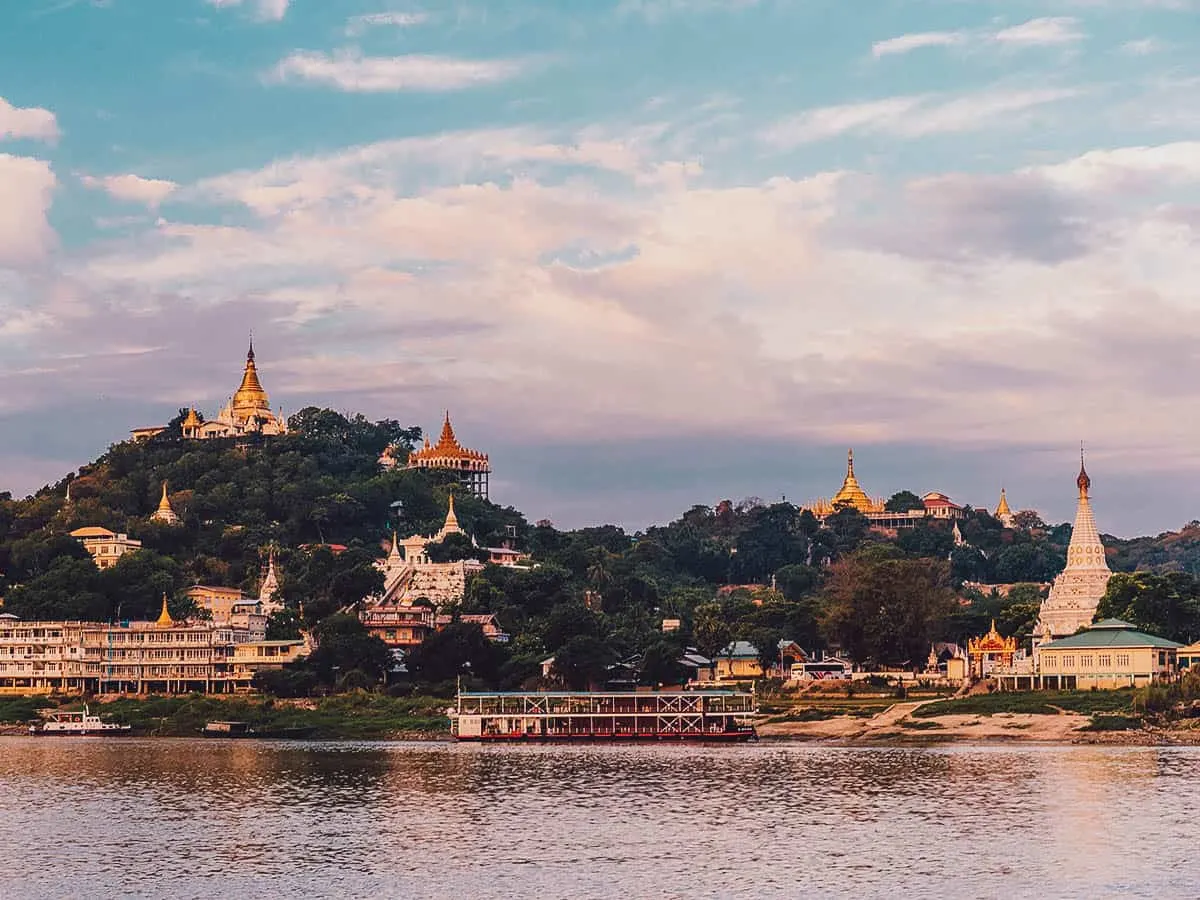
Photo by Framalicious via Shutterstock
WHERE TO EAT
1. The Moon (2) Be Kind To Animals
As you can probably guess from its unusual name, this is a vegetarian restaurant, and a great one at that. It was the very first place I went to when I drove out of my hotel on my e-bike.
Pictured below is their Bagan set menu with soup, white rice, vegetable curry, eggs with soya bean curry, vegetable tempura, tomato salad, and pennywort salad. I got my first taste of Burmese vegetable tempura in Yangon the day before which is why I went with this set menu. Everything was good but the vegetable tempura was terrific.
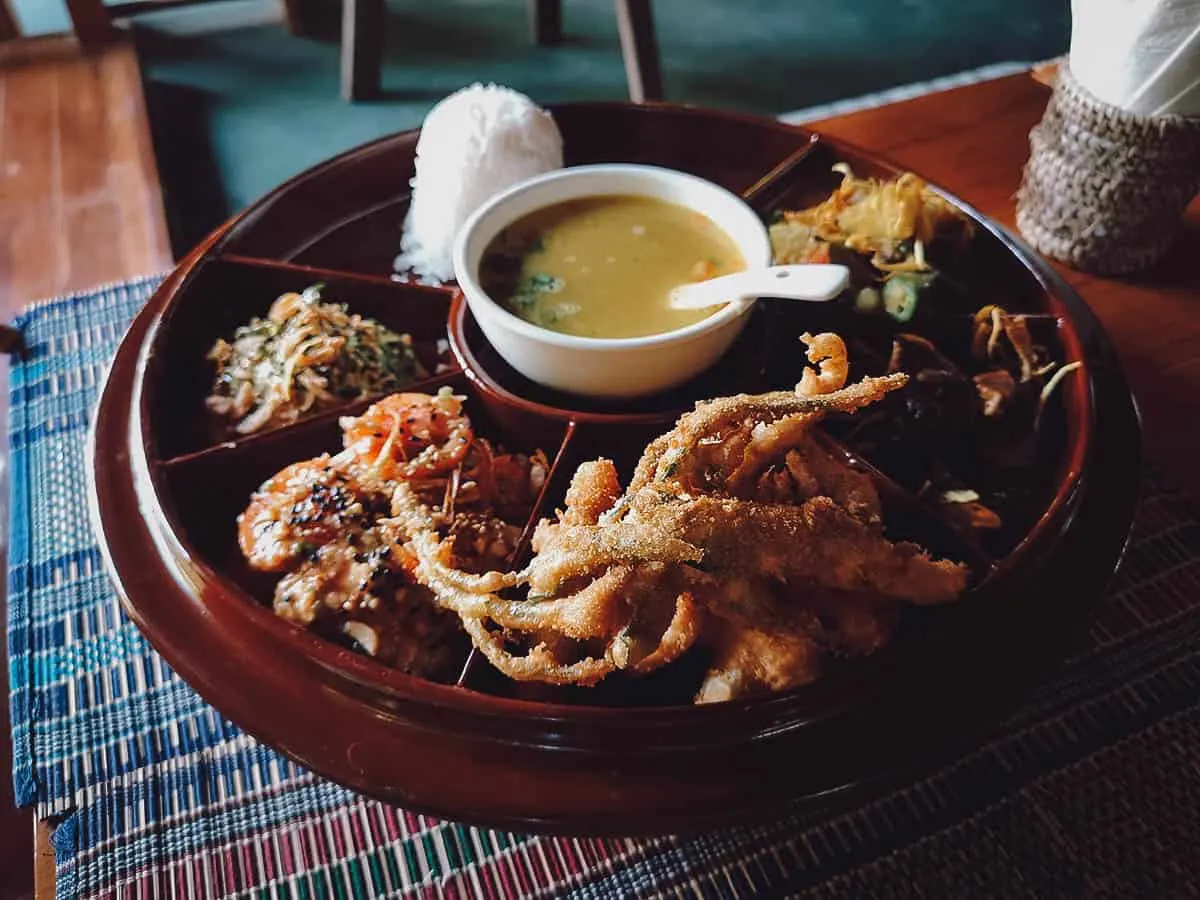
The Moon (2) Be Kind To Animals is a lovely open-air restaurant in New Bagan. As its name suggests, this is the restaurant’s second branch, the first being in Old Bagan. Both are TripAdvisor Certificate of Excellence awardees with 4.5-star ratings.
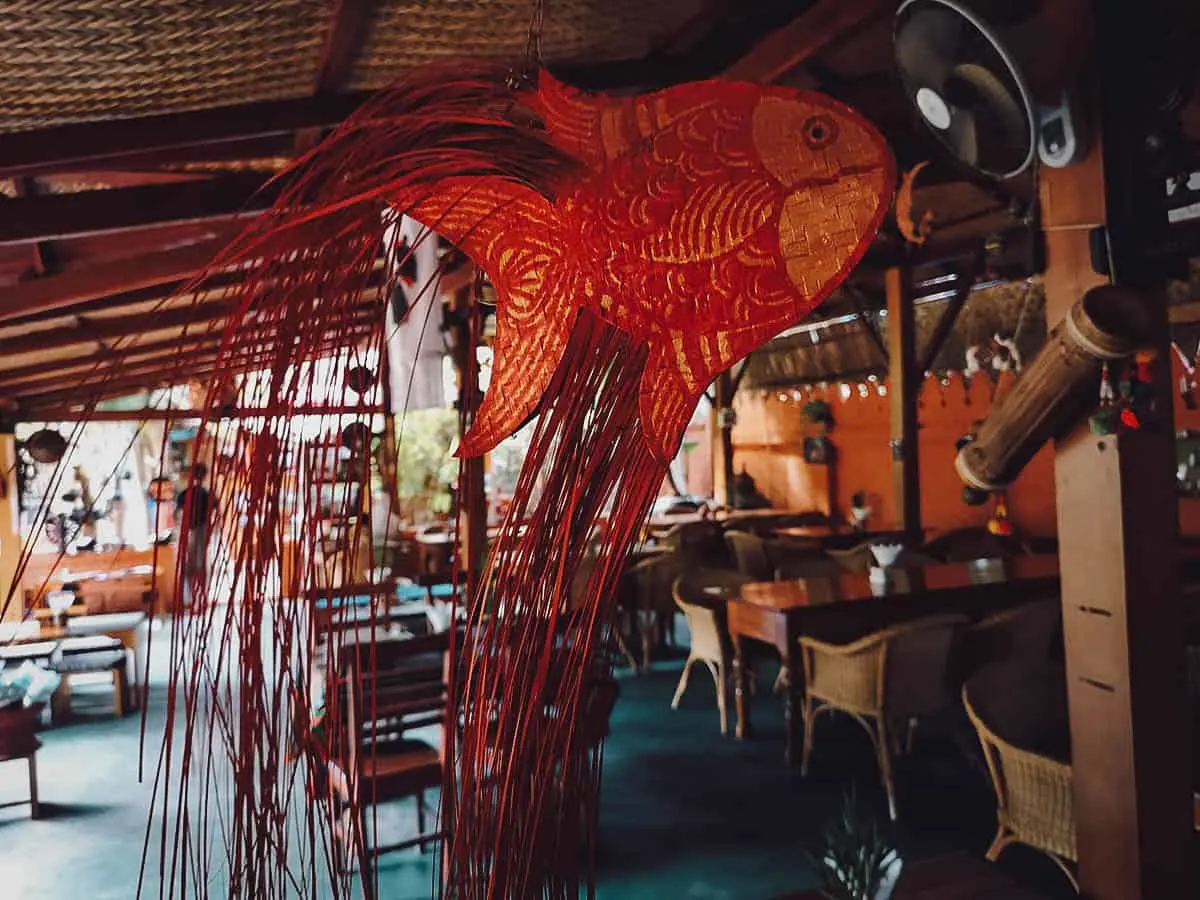
Expect to Pay: MMK 8,000 for the Bagan set menu
2. Ma Mae Naing
Ma Mae Naing is a humble restaurant by the side of the main road in New Bagan. It’s a bit dusty and unkempt but don’t let its shack-like facade fool you. Like The Moon (2) Be Kind To Animals, Ma Mae Naing is a TripAdvisor Certificate of Excellence awardee with a stellar 4.5-star rating.
I had this simple but tasty curry set menu with seasonal vegetables, soup, and rice for a ridiculously low MMK 3,000. I loved the variety in texture and flavor from all the different vegetables.
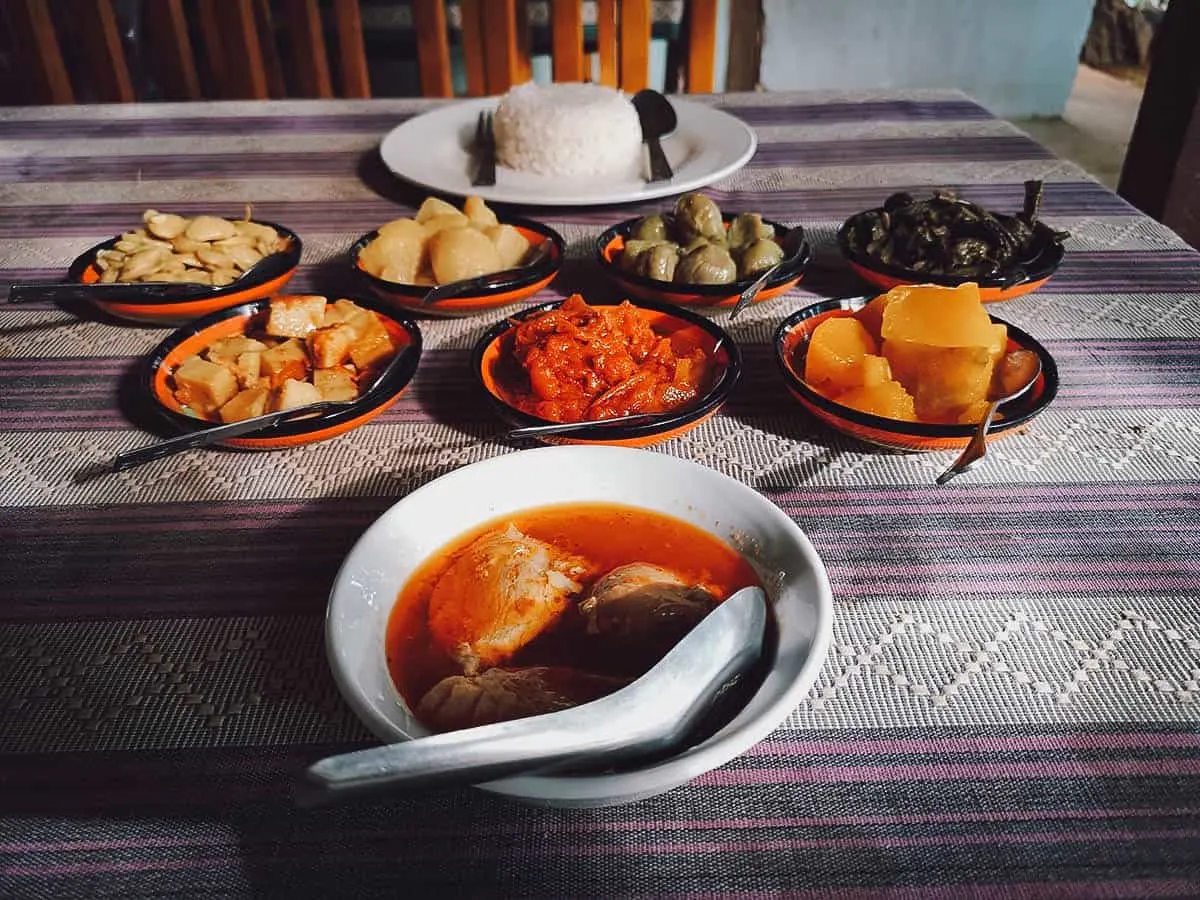
I chose chicken curry but you can also have it with river fish, beef, pork, or mutton curry. It’s a simple but delicious and filling meal at a great value.
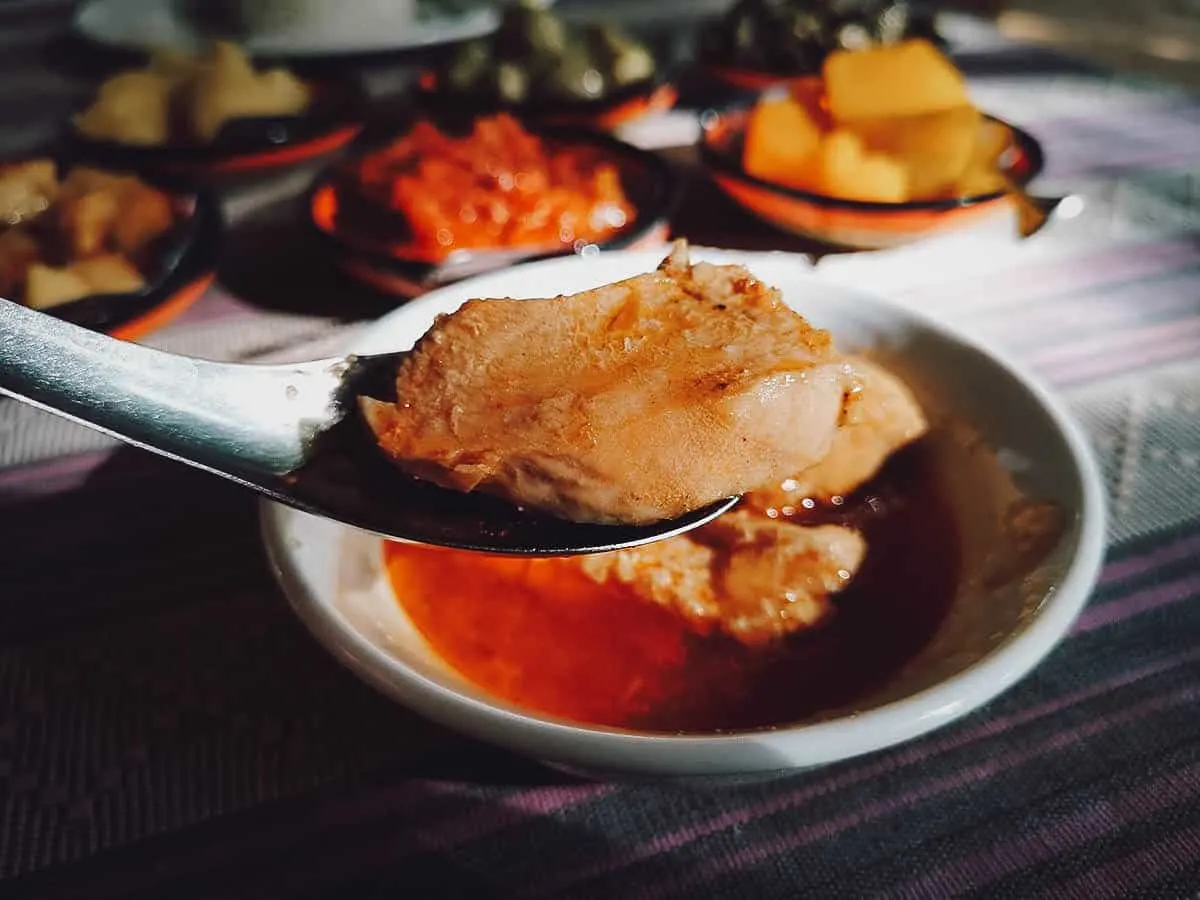
Expect to Pay: MMK 3,000 for the curry set menu
3. Sanon Training Restaurant
I guess you could call this the “fanciest” meal I had in Bagan. What you’re looking at is a scrumptious dish of giant Irrawaddy prawn and catfish curry with acacia leaves and a bowl of jasmine rice. I asked my server for recommendations and this was one of the dishes he pointed out. Tomato-ey and a little tangy, it was like eating a cioppino made with just catfish and a hefty prawn.
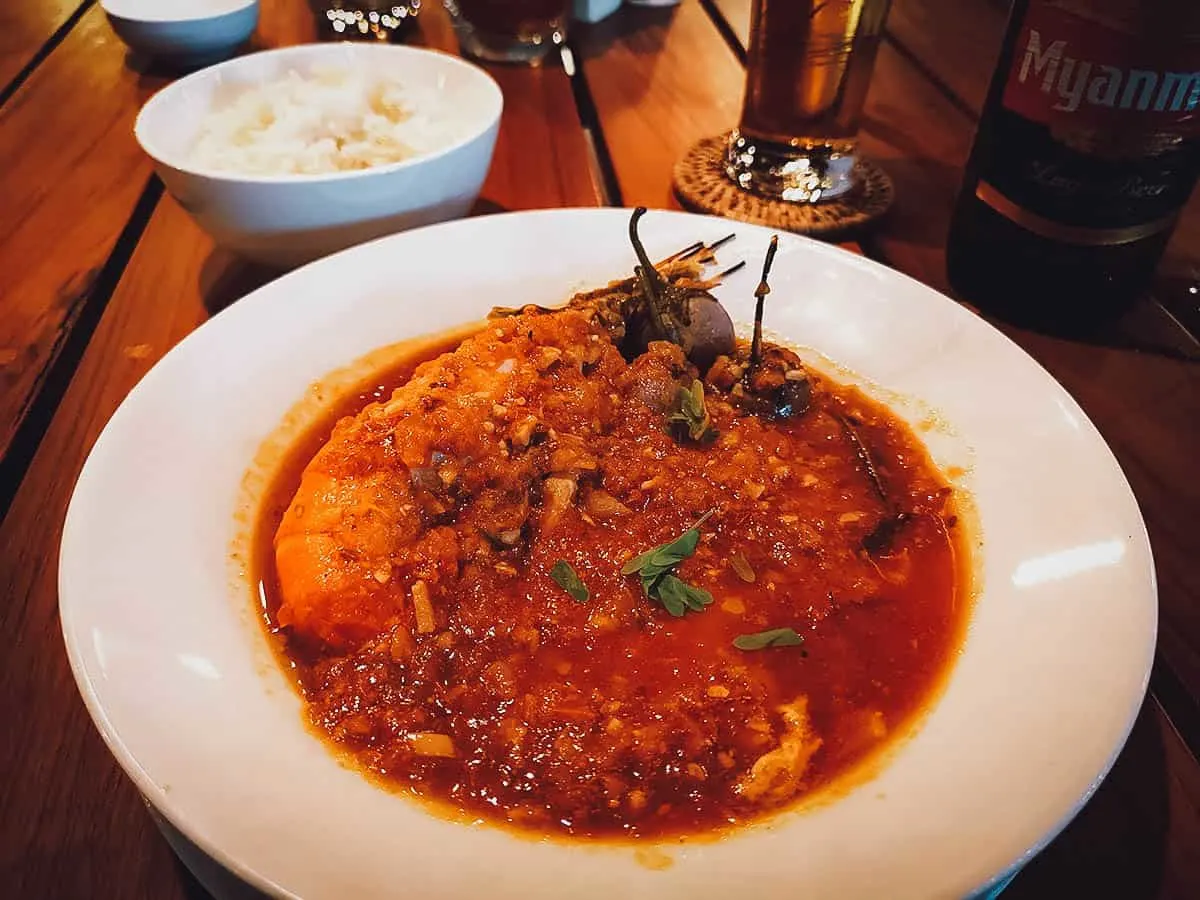
Like the previous two restaurants, Sanon Training Restaurant is a TripAdvisor Certificate of Excellence awardee with a near perfect 4.5-star rating. It’s a lovely open-air restaurant in Nyaung-U that serves good food for a great cause.
If you’re wondering why the word “Training” is in the restaurant’s name, it’s because Sanon trains up to thirty students a year to work in the hospitality industry. They train students from disadvantaged backgrounds then help them find employment after they graduate from the 12-month program. They’re then monitored for another two years to help ensure their success.
It’s a great program that you can help support simply by enjoying a meal here. When the food is this good, you can hardly think of it as charity.
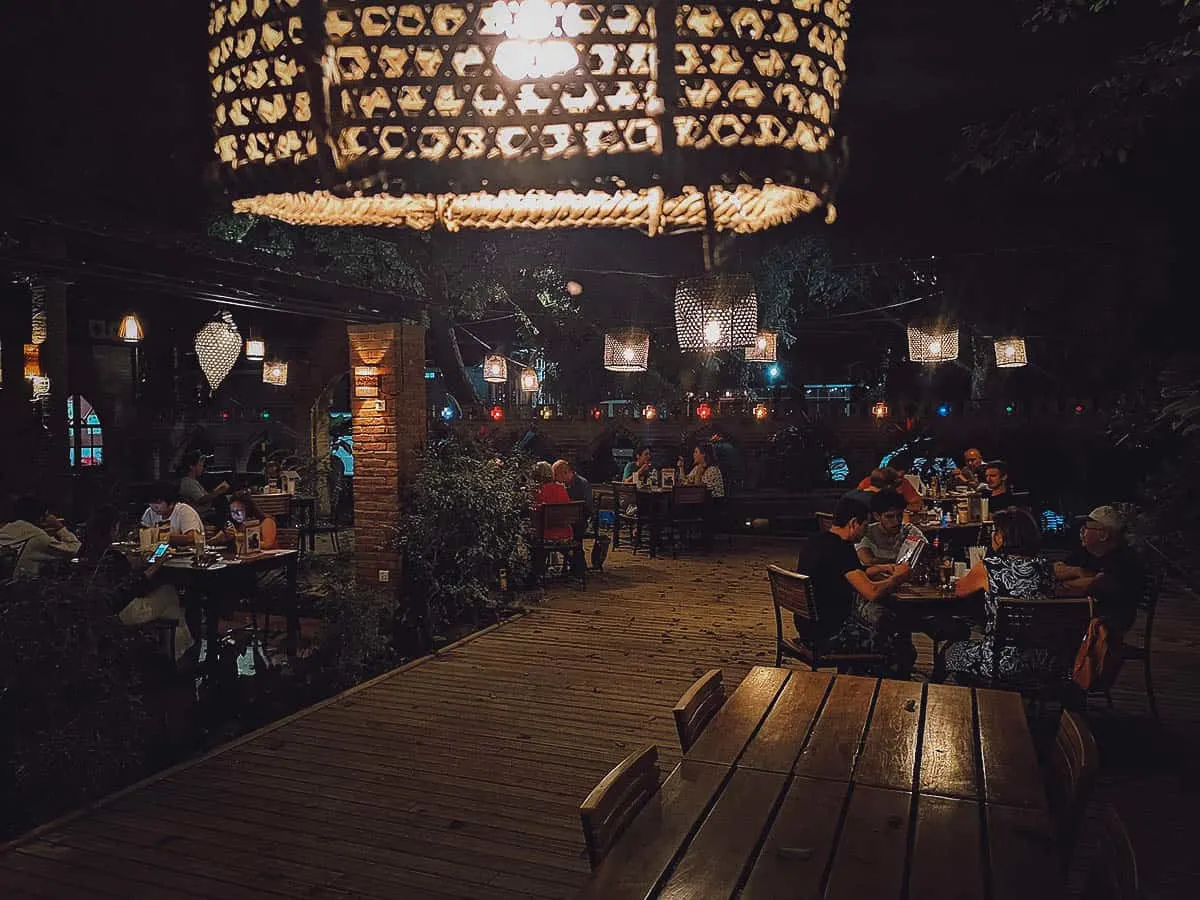
Expect to Pay: Around MMK 10,000-15,000 per person
4. Bibo
I had my last meal in Bagan here at Bibo. Had I known that this dish of Bagan-style pork curry would be that good, then I would have come back. This was hands down the single best dish I had not just in Bagan, but in all of Myanmar. It was absolutely delicious and something I wasn’t expecting at all.
I asked my server for recommendations and he pointed me to this dish which he described as being a specialty of the region. He didn’t say anything else so I don’t know much about it, but I believe it was made with black beans hence the heavy dark color. It almost looks like it were cooked with pig’s blood.
Whatever it is, it was incredibly tasty – nuanced in flavor and a perfect dish to pair with white rice. It was so good I would have been happy with just the sauce to eat with my rice. I loved it.
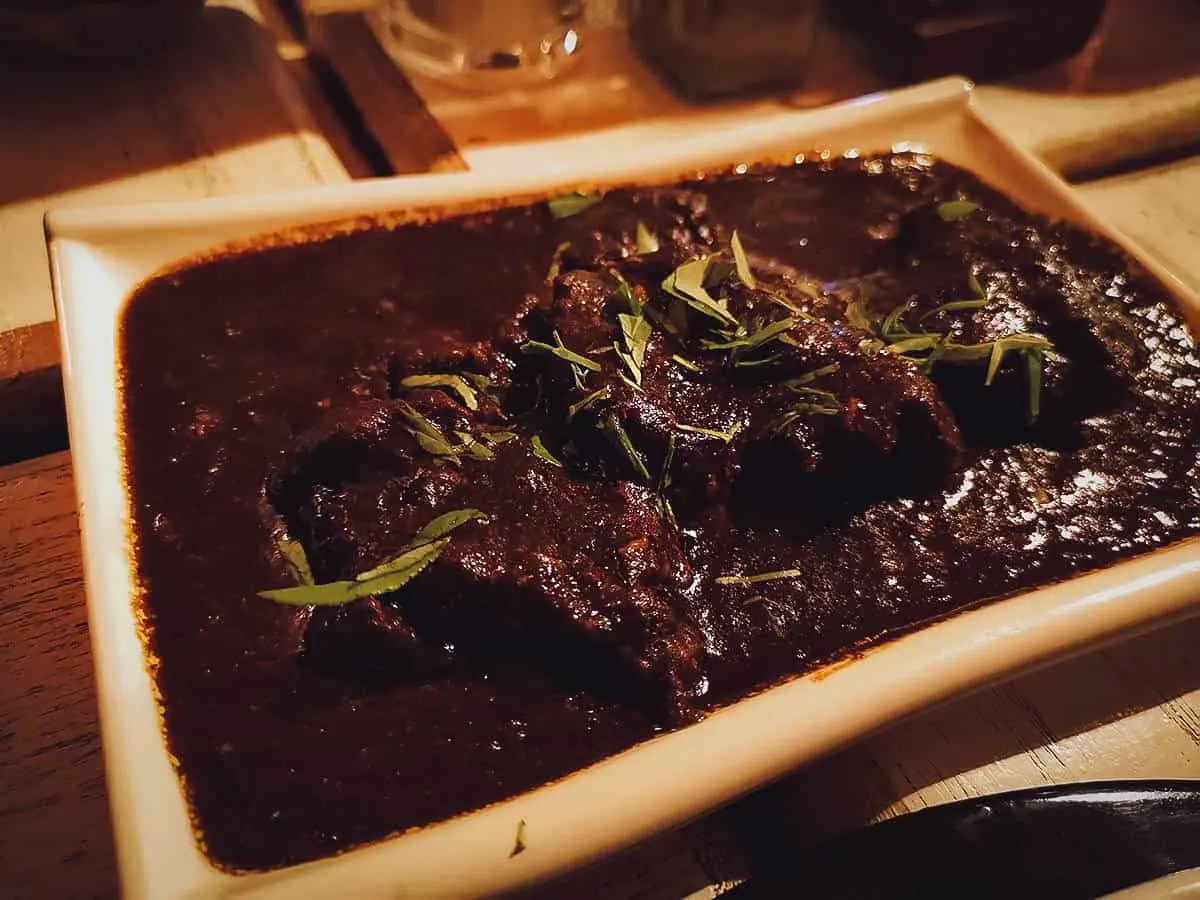
Like every other restaurant on this list, Bibo is a TripAdvisor Certificate of Excellence awardee with a stellar 4.5-star rating. Don’t miss it.
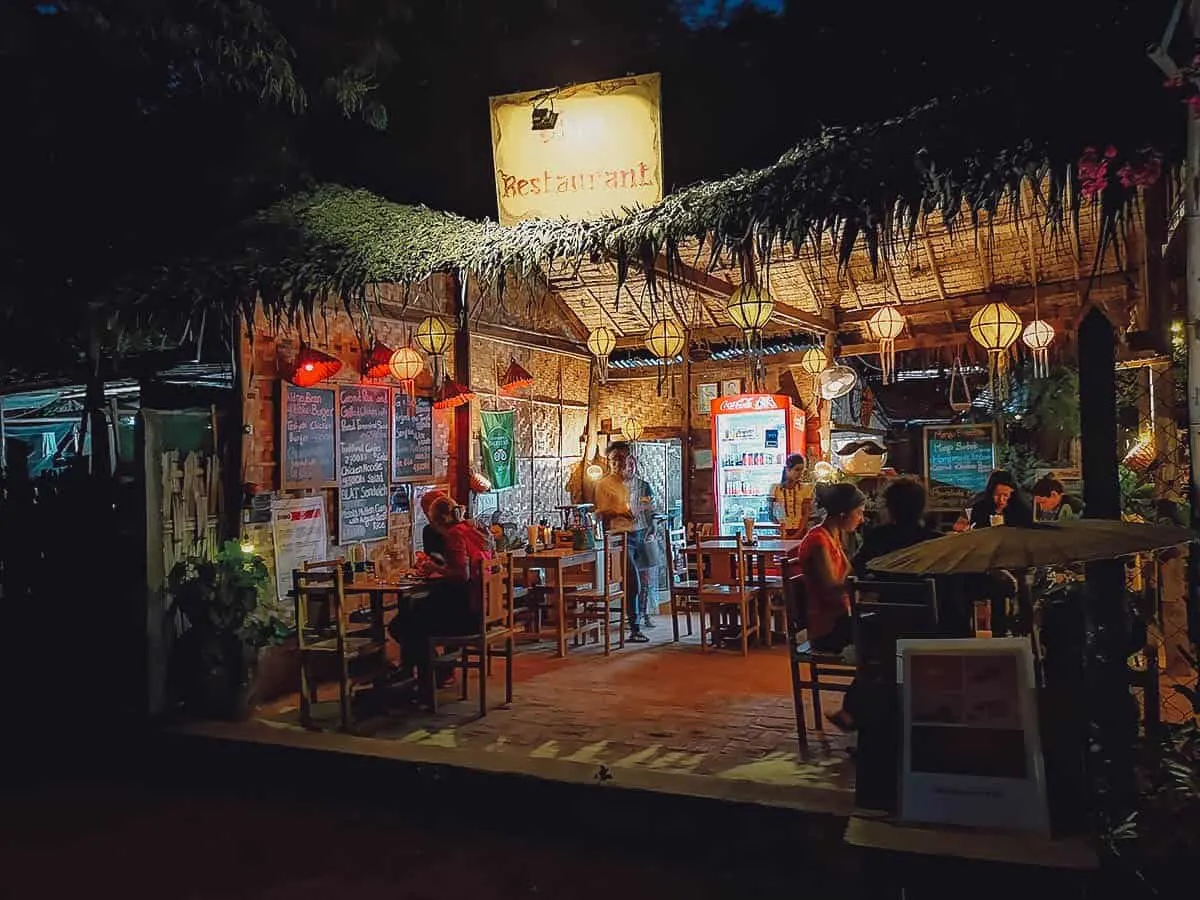
Expect to Pay: About MMK 4,500 per entree
POINTS OF INTEREST IN BAGAN
To help you understand where everything is, I’ve pinned all the places recommended in this guide on this map. Zoom in for a closer look.
HOW MANY DAYS TO STAY / SAMPLE ITINERARY
If you’re in Bagan just to visit the temples, then I’d say two full days is enough, especially since buses to and from Yangon arrive early in the morning and leave late at night. You can spend the first day exploring all the popular temples then the second day just winging it.
Many blogs will tell you to stay longer but in my case, temple fatigue set in and I found myself just driving by temples without any desire to go in. If you’re like me, then two days will be enough. But if you have a keen interest in temples, then you can certainly stay longer, especially since the archaeological entrance fee is good for five days.
Here’s a sample 2D/1N Bagan itinerary to help you plan your trip.
| DAY ONE • Shwezigon Pagoda • Htilominlo Pahto • Shwesandaw Pagoda • Dhammayangyi Pahto • Ananda Pahto • Shwegu Gyi Phaya • Thatbyinnyu Temple • Sunset at Bupaya Pagoda |
| DAY TWO • Sunrise near Dhammayazika Pagoda • Early morning at Mani Sithu Market • Get off the main roads and explore Old Bagan • Visit lacquerware shops in Myinkaba Village • Sunset at Lawkananda Pagoda |
TRAVEL TIPS
1. Plan your Trip with Sygic Travel
What’s the hardest part about trip planning? For me, it’s creating an efficient itinerary. Finding all the must-dos and must-eat restaurants is easy but putting them all together can sometimes be challenging. Thankfully, I have Sygic Travel to help me with that.
I’ve been using this free trip planning app for several years now. It allows me to plot all points of interest on a map so I can come up with as efficient an itinerary as possible. It isn’t as essential in Bagan but you can use it to map out all the temples you want to visit. Follow the link to check out my 2-day Bagan itinerary on Sygic Travel.
2. Rent a Pocket Wifi Device
Having reliable access to the internet is important in every destination but I found it to be vital in the Bagan Archaeological Zone. I went off-roading on my e-bike so I needed a good internet connection to see exactly where I was on a map. It’s easy to get lost without access to GPS so I wouldn’t have been as confident without it.
We prefer pocket wifi devices when we travel but they don’t seem to be all that common yet in Myanmar. I brought my own device with me so I didn’t need to worry about wifi connectivity in Bagan, but it looks like the more common option is to purchase a SIM card with a data package. You can do that when you land at Yangon Airport. Otherwise, you can buy one in Bagan.
If you’re traveling to Myanmar from somewhere in Asia, then you may be able to book a pocket wifi device or purchase a SIM card in advance through Klook.
3. Pay the Archaeological Fee
As described, the Bagan archaeological fee is MMK 25,000 and it’s good for five days. When I arrived by bus, my taxi went through a checkpoint where I could pay the fee. Be sure to always keep your ticket with you as you may be asked to present it at any time.
When I was doing research before my trip, I found blog posts and forum threads advising people on how to avoid paying the archaeological fee, which I found ridiculous and annoying. That’s the rule here. If you want to visit Bagan, then you need to play by the rules. If you can’t, then don’t go. It’s that simple. The fact that you’re traveling on a budget isn’t an excuse. Try giving that same rationale to a Ferrari dealer and let’s see how far that gets you.
At the opposite end of the spectrum, I’ve read it’s common for corrupt officials to try and scam tourists by marking up the archaeological fee. At the time of this writing, it’s MMK 25,000. The price will be on the ticket so never pay more than what’s stated there, no matter what anyone tells you.
4. Get Off the Beaten Path
I listed many of Bagan’s most popular temples earlier in this guide because it’s good to have a starting point. But as described, the most fun I had was when I got off the main roads and just explored Bagan without any real destination in mind.
I don’t mean any disrespect when I say this, but after the first few temples, they started looking a little “same same” to me. That’s when I knew temple fatigue had set in. I stopped entering every temple and decided to just cruise around and appreciate this unique landscape and the freedom I had to explore it. At the end of my trip, that’s what I enjoyed most about Bagan and why I want to go back.
Like any destination, it’s important to visit the “must-sees” but do allow yourself time for some spontaneity as well.
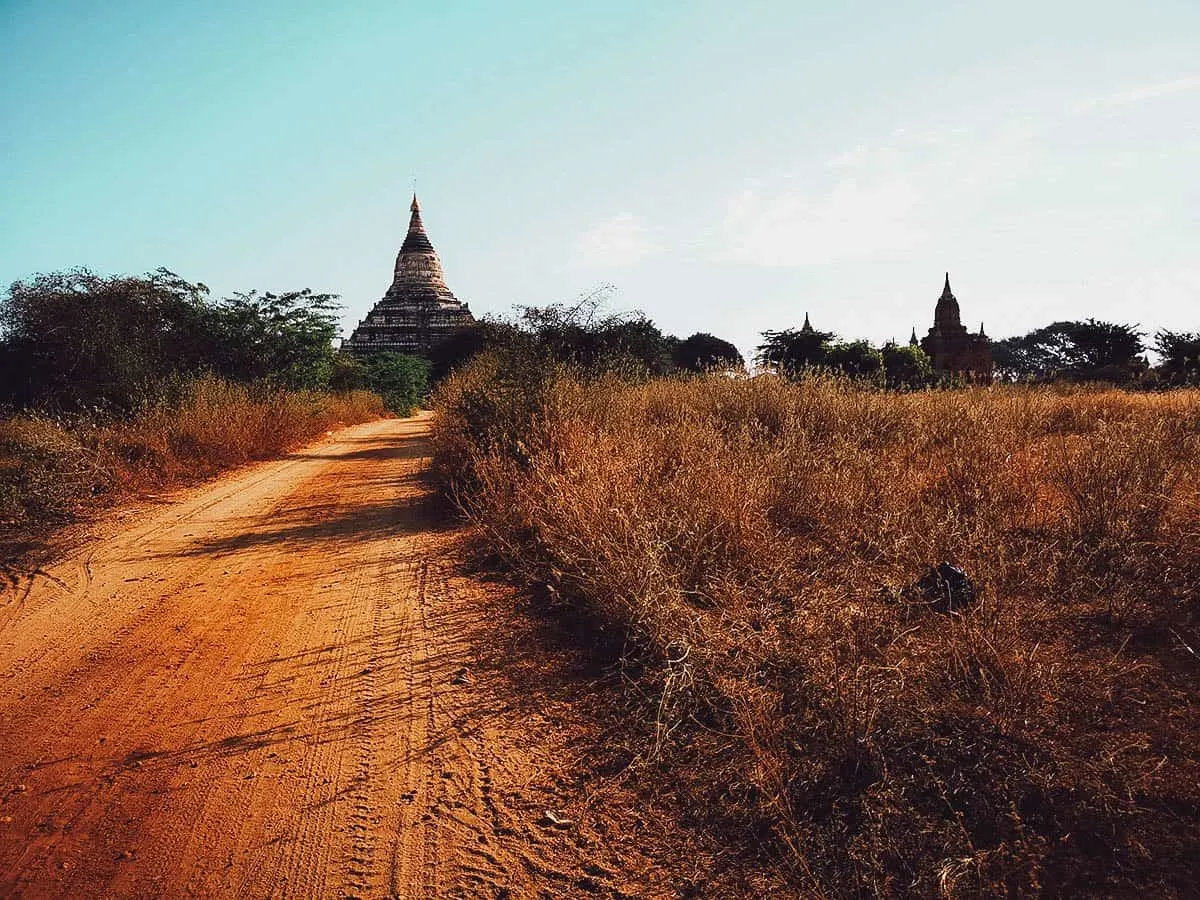
All my fondest memories of Bagan involve lesser known temples. I don’t know what it’s called, but pictured below is the temple I found with stairs leading up to the roof. This was where I sat with a bunch of strangers to enjoy the sunset on my last day in Bagan.
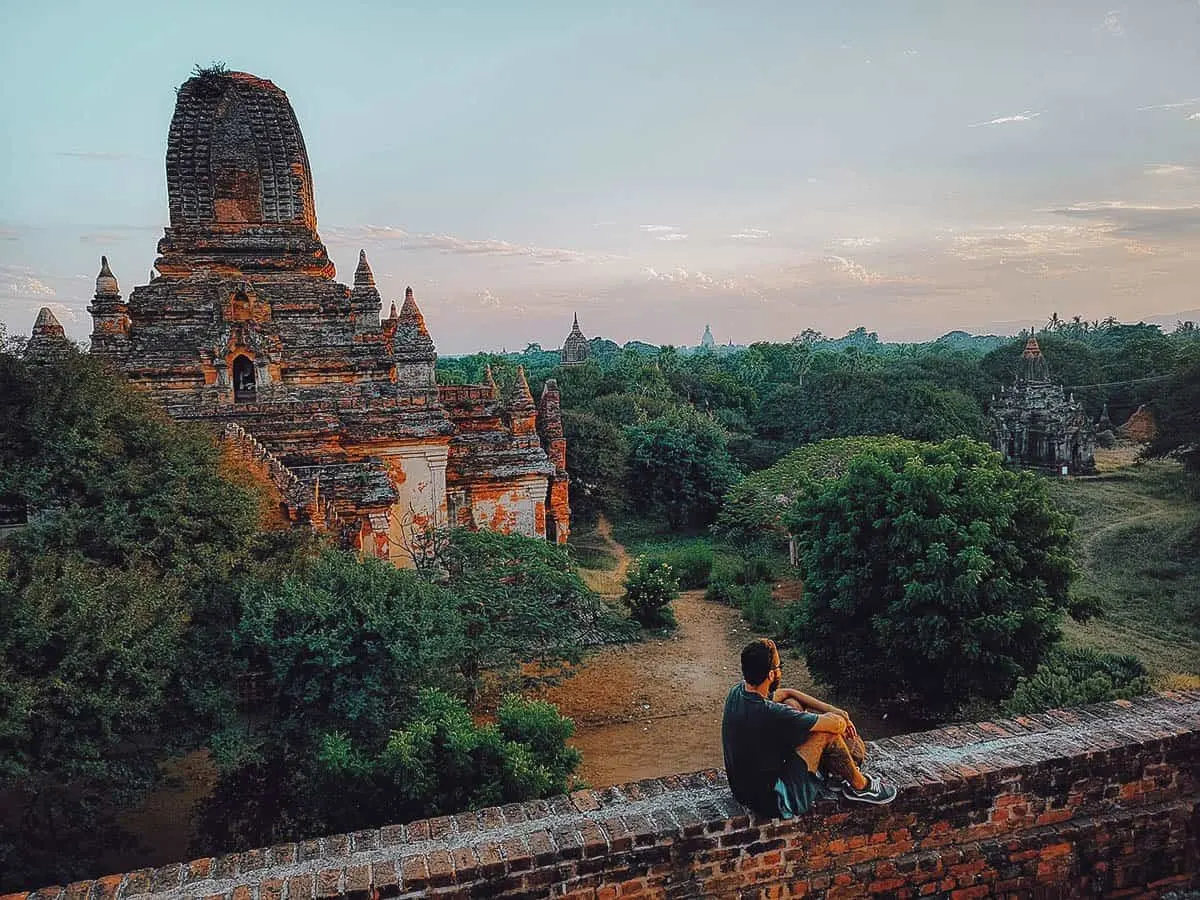
5. Beware the Taxi Mafia
Taxi mafias are a pain. They have an established one in Phuket and it made getting around so much more expensive.
Unfortunately, they have one in Bagan as well. From the looks of it, they prey mainly on travelers arriving early in the morning by bus. I think it’s because traveling by bus gets you into Bagan between 5-6AM when there are fewer transfer options. As previously described, I fell victim to the taxi mafia and wound up paying a lot more to get to my hotel.
According to Wikitravel, Bagan’s taxi mafia has such a stranglehold on transfers from the terminal that JJ Express explicitly states on their website that they cannot provide free shuttle transfers to foreigners. This explains why my outbound ticket included free shuttle transfers but my inbound ticket didn’t.
Sadly, there doesn’t seem to be an easy solution to this. If you can arrange for a fair transfer with your hotel, then do that. Otherwise, you’ll need to rely on your bargaining skills to try and get the fare as low as you can.
6. Check for Discount Tickets
We buy travel-related deals on a few different websites but for destinations in Asia, our favorite is Klook. They offer the biggest selection at the best prices. Follow the link for a list of Bagan deals on Klook.
7. Get Travel Insurance
When it comes to getting travel insurance, I normally say it depends on where you’re going, what you’ll be doing, and how long you’ll be away for. If you plan on renting an e-bike or a bicycle to explore Bagan’s temples, then there’s no question in my mind. You should definitely get a policy. You don’t want to crash face-first into a temple and not have travel insurance.
We always get travel insurance from SafetyWing. They’re a popular travel insurance provider used by many long-term travelers. You can follow the link to get a free quote from SafetyWing.
8. Bring the Right Power Adapter
Myanmar has Type C, Type D, Type F, and Type G electrical outlets so be sure to bring the right power adapters for your devices. Electrical voltage is 230V and the standard frequency is 50Hz.
Have fun!
I’m not an expert on Bagan but I do hope you find this guide helpful. I’m only sharing the things I learned from my trip. If you have any questions, comments, or suggestions, then please leave them in the comment section below.
Thanks for reading and have an amazing time exploring the temples in Bagan!
Disclosure
Some of the links in this guide are affiliate links, meaning we’ll earn a small commission if we make a sale at no added cost to you. We only recommend products and services that we use ourselves and firmly believe in. We really appreciate your support as this helps us make more of these free travel guides. Thank you!


Amy
Sunday 28th of May 2023
Hiya,
Thank you for the blog. What date did you travel? I want to check for ease and safety issues. I'm thinking of going in July. Thank you
JB & Renée
Sunday 28th of May 2023
Hi Amy, my last trip was pre-pandemic so I don't know what the situation is like today.